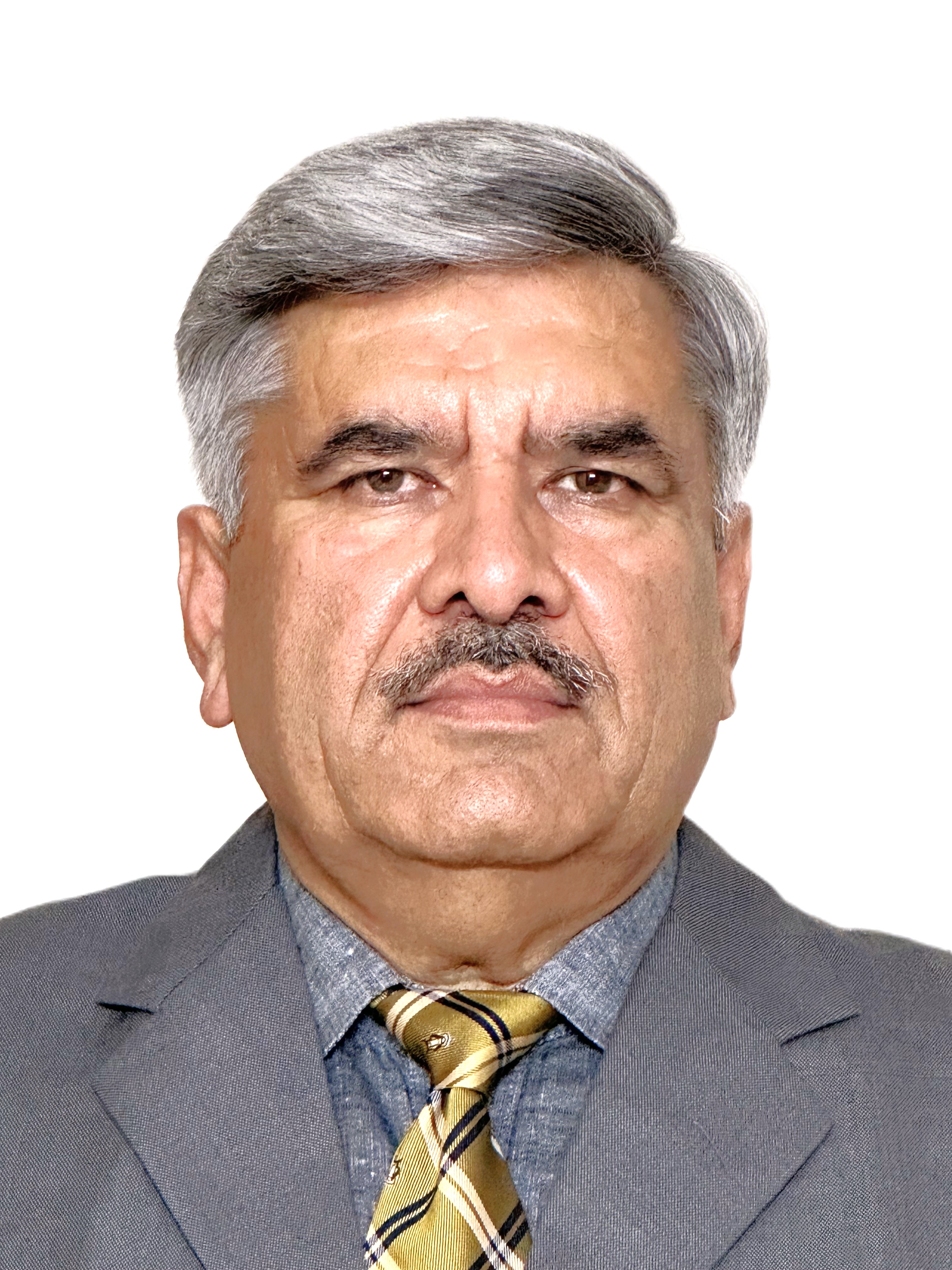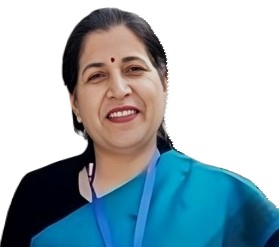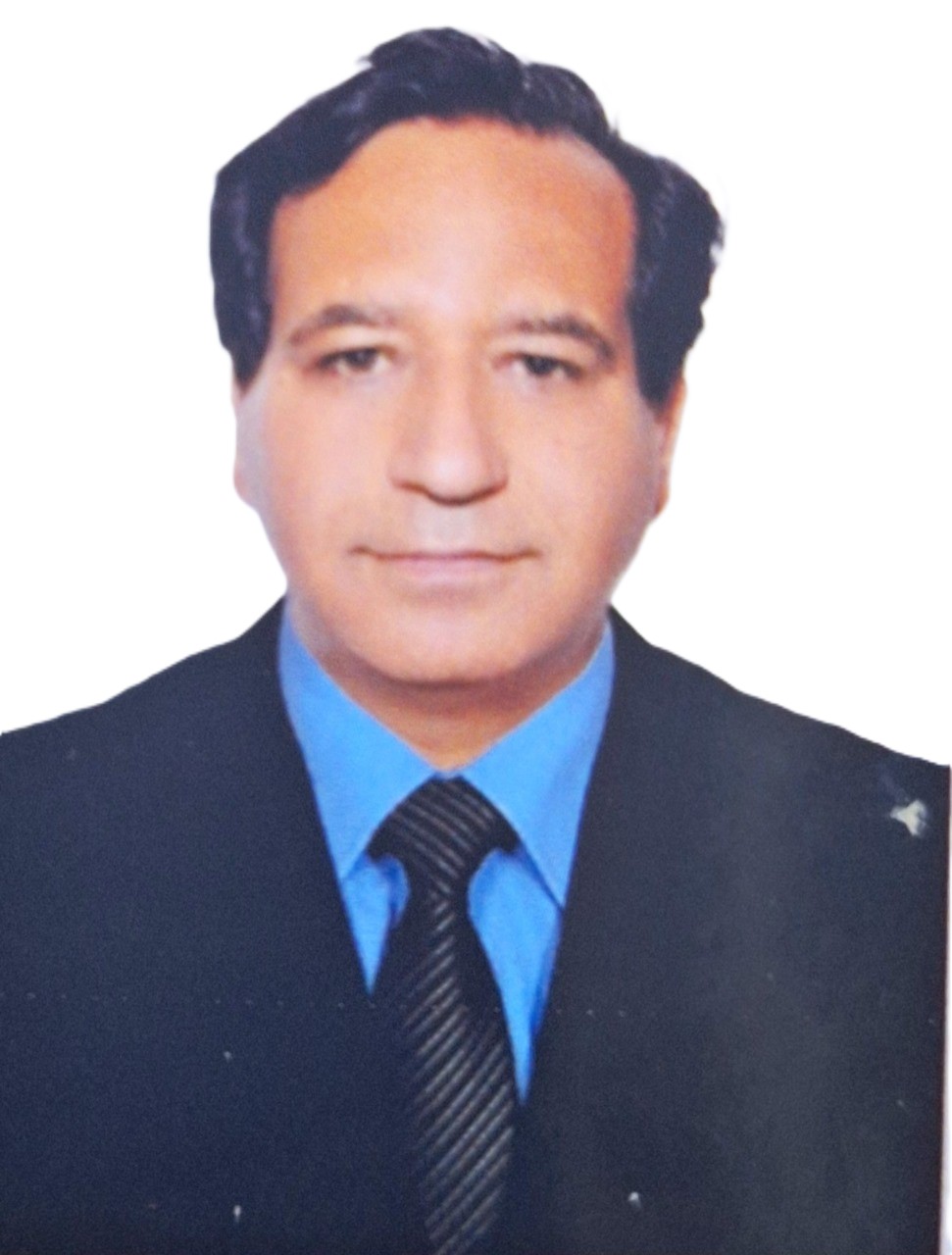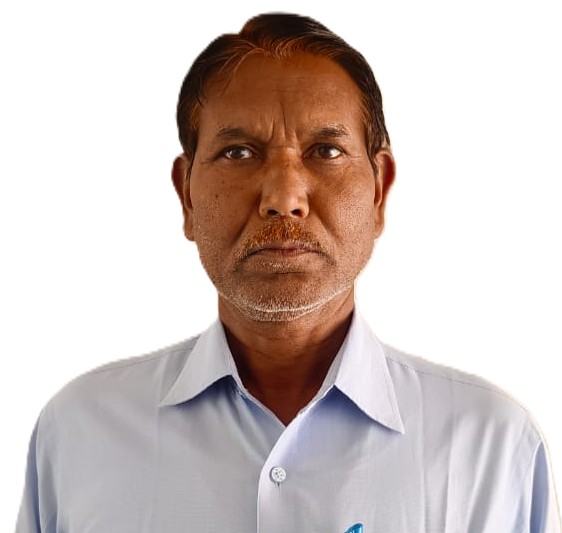DIVISION OF GERMPLASM EVALUATION

Head of Division: Dr. Raj Kumar Gautam
Contact Numbers: 011-25848074 Extn 415; Fax:011-25842495 Mobile +91 9933247901, 9476011617
Address: ICAR-National Bureau of Plant Genetic Resources, Pusa Campus, New Delhi – 110012, INDIA
E-mail: Raj.Gautam-icar@nic.in, rgautampb@gmail.com
Google Map
Mandate
- Characterization and preliminary evaluation of major agri-horticultural crops for important agro-morphological descriptors.
- Development and validation of core/ mini core/ trait-specific reference sets of major crops.
- Evaluation and identification of trait-specific germplasm for agronomic traits, biotic & abiotic stresses and quality parameters.
- Crop wild relatives and pre-breeding to widen the genetic base.
- Organization of germplasm field days and germplasm supply for enhanced utilization of genetic resources.
Salient Achievements
- A total of 1,18,558 accessions of various agri-horticultural crops including cereals (39,449), pulses (44,688), oilseeds (27,968) and vegetable (6,453) were characterized/evaluated/regenerated/multiplied during the period 2014-15 to 2022-23, whereas during the period 2006-07 to 2013-14, a total of 52,680 accessions of various agri-horticultural crops including cereal (23,598), pulses (13,645), oilseeds (6,578) and vegetable crops (8,859) were characterized/evaluated/regenerated/multiplied. In addition, 401 accessions of medicinal and aromatic Plants (Ocimum, Aloe vera, Palmarosa, Giloe, etc.) are being grown on the Issapur farm. The characterization data is regularly documented in NBPGR in user-friendly databases PGR Portal.
- Under CRP on Agro-biodiversity-PGR Component-II, a total of 24,602 accessions comprising wheat (7763 acc.), rice (5900 acc.) and okra (3412 acc.), chickpea (2136 acc.) and brassica (2953 acc.) were evaluated at AICRP centres/hotspots for quality traits, abiotic and biotic stresses during the period 2014-15 to 2020-21.
- Mega-characterization and evaluation of entire germplasm of wheat (~22000 accessions comprising aestivum, T. durum and T. dicoccum) conserved in the National Genebank, at three locations during Rabi 2011-12 entered into Limca Book of Records 2013. At CCS HAU, Hisar, the wheat accessions have been characterized under optimum conditions using 34 agro-morphological characters to develop a core-set. At IARI Regional Station, Wellington wheat germplasm were screened against rusts and other major foliar diseases and subsequent evaluation of tolerant/resistant genotypes at hot-spot locations led to identification of multiple diseases tolerant germplasm. At NBPGR, Issapur Farm, two sets of wheat germplasm, one under normal sowing and the second set under late sowing were screened for terminal heat tolerance and a reference set for component traits associated with terminal heat tolerance were identified.

- Core Collections/ Mini-Core Collections representing the complete variability in the entire collection conserved at National genebank have been developed in many crops to facilitate the utilization of germplasm in crop improvement programme. Trait-specific Reference sets also have been developed after evaluation of germplasm for various biotic/abiotic stresses.
| Crop | No. of accessions in the Core collection | Publication details and link |
| Linseed core collection | 259 | Kaur et al., 2023 (Industrial Crops & Products 206: 117657); doi: https://doi.org/10.1016/j.indcrop.2023.117657 |
| Barley mini-core collection | 107 | Sonia et al., 2023 (Plant and Soil); doi: https://doi.org/10.1007/s11104-023-06397-6 |
| Reference set for linseed bud fly (Dasyneura lini Barnes) resistance | 195 | Nair et al., 2023 (Industrial Crops & Products 207: 117743); doi: https://doi.org/10.1016/j.indcrop.2023.117743 |
| Lentil core collection | 170 | Tripathi et al., 2022 (Front. Plant Sci. 12:751429); doi: https://doi.org/10.3389/fpls.2021.751429 |
| Barley core collection | 678 | Kaur et al. 2022 (Front. Plant Sci. 13:771920); doi: https://doi.org/10.3389/fpls.2022.771920 |
| Wheat core collection | 2226 | Phogat et al., 2021 (Crop Science 61:604–620); doi: https://doi.org/10.1002/csc2.20285 |
| Chickpea core collection | 1103 | Archak et al., 2016 (The Crop Journal 4:417-424) https://doi.org/10.1016/j.cj.2016.06.013 |
| Brinjal core collection | 181 | Gangopadhyay et al., 2010 (Crop Science 50:755-762) https://doi.org/10.2135/cropsci2009.03.0151 |
| Wheat mini-core collection | 224 | |
| Pea core collection | 244 | |
| Cowpea core collection | 425 | |
| Sesame core collection | 763 | |
| Ricebean core collection | 252 | |
| Reference set for drought tolerance in linseed germplasm | 200 |
- Quality evaluation of germplasm is gaining importance worldwide because of their key role in providing nutritional security. A total of 13,444 germplasm accessions of different agri-horticultural crops were analyzed for various nutritional quality traits and phytochemical evaluation.
- In cereal crops, the evaluation of 1150 accessions of rice was done for protein, starch, amylose, oil, dietary fibre, phytate. The superior accessions IC386358, IC206830, IC518120, IC85930, IC205951, IC612377for high protein content (>11%) and IC516811, IC518677, IC206040, IC516811, IC203309 for high amylose content (>28%) were identified. A set of 3725 accessions of wheat were evaluated for protein and amylose. The accessions IC252830, IC531489, IC296727 were identifiedfor high protein content (>19%). Promising accessions IC427140, IC542076, ET201192, IC212145 for high amylose content (>30%) and EC542277, EC339601 for low amylose content (<10%) have been identified.
- In pulses, biochemicalevaluation of 520 accessions of cowpea, 142 accessions of urdbean and 151 accessions of green gram was done for protein, starch, amylose, dietary fibre, phytate, phenols and sugars. The promising accessions with high protein content (>26%) were identified in cowpea (EC390248, IC214752, EC390263), urdbean (IC0330874, IC0341031, IC331705) and green gram (IC148442, IC354429). Similarly, the accessions EC390278, EC723824 in cowpea; IC297661, IC419987, IC485484 in urdbean and IC436605, PLM622 in green gram were identified as superior for low phytate content (<0.5%). The evaluation of 525 accessions of mothbean was done for protein, starch, amylose and phytate. The superior accessions IC39738, IC25938, IC36664 for high protein content (>29%) and IC113706, IC39640 with low phytate content (<0.55%) were identified.
- Accessions with high protein content in legumes viz. cowpea (IC536626, IC536637), lentil (IC201700, IC560128) and moth bean (IC016220, IC258109) have been identified.
- Superior accessions belonging to various crop species were identified and documented. These included Brassica juncea (IC423195), yellow sarson (IC385670, IC199737), brown sarson (IC355412), toria (IC355480, IB186), napus (IC481586), B. chinensis (EC182654, EC182684), B. rapa (IC363765, IC363733), Eruca sativa (IC350145), B. nigra (IC566706) and Guizotia abyssinica (IC372579) and non-conventional tree borne oilseed, Samadera indica Gaertn. (IC277402) with high oil content (53.94%). Promising accessions for high oil content IC204253 (52.07%) and EC346597(50.12%) in sesame and IC0054952 (50.90%) and IC0525973 (50.87%) in linseed were identified.
- Accessions with high oil and protein contents were analyzed for fatty acids and amino acids profile, respectively. Antinutritional factors such as total glucosinolate in Brassica (200 acc.) and phytic acid in pearl millet (30 acc.) were estimated.
- Antioxidant profiles including its constituents such as phenol, O-dihydric phenol, flavonoids, sugar and ascorbic acid were determined in walnut accessions. Similarly, kodomillet samples were analysed for tryptophan content.
- Mineral content (K, Mg, Fe, Cu and Zn) and anti-oxidant activity has been estimated in brinjal and fenugreek germplasm. Superior accessions of brinjal such as IC413648 (K), IC545854 (Mg), IC545854 (Cu), IC090785 (Fe) and IC261785 (Zn) were identified.
- A superior and easy method for estimation of steroidal sapogenin in methanolic extract of fenugreek seeds was standardized as compared to the commonly used method (Baccou et al., 1977).
- Major medicinal and aromatic plants such as Ocimum, Alpinia, Andrographis and Mucuna were analysed for their active compounds and promising accessions were identified. Out of 1646 samples analysed, following accessions were found promising: Ocimum sanctum (IC583284), Kaempferia galangal (IC550136), Alpinia galangal (IC 34974), Mucuna pruriens (IC551549), Andrographis paniculata (IC520361). Some of the accessions like Ocimum basilicum (IC469904 and IC370846 (Methyl chavicol rich); EC338782 and EC387837 (Linalool rich); EC388893 and IC328582 (Linalool and methyl chaviol rich); IC261161 (Methyl cinnamate rich)); Ocimum sanctum (IC583281, IC583285 (Eugenol Rich)); Kaempferia galangal (IC210388 (Trans-ethyl cinnamate rich)); Oregano vulgare (IC589087, IC589085 (Thymol rich), IC589079 (Carvacrol rich)) were found promising for essential oil composition.
- Germplasm of various field crops are also being evaluated for major diseases, insect-pests and nematodes. Preliminary evaluation under field conditions is carried out to identify the tolerant/resistant genotypes which are then further validated under controlled conditions / artificial inoculation. Various crops have been screened namely, pearl millet (223 acc.) against foliar diseases, rapeseed-mustard (713 acc.) against aphid, black gram (344 acc.) against defoliators and mosaic virus, chickpea (90 acc.) against Ascochyta blight, lentil (30 acc.) against wilt, okra (192 acc.) against YVMV, tomato (582 acc.) and brinjal (200 acc.) against fruit borers and promising accessions were identified.
- Among oilseed crops, evaluation of mustard germplasm (1442 accessions) for white rust and powdery mildew revealed two accessions (EC766192 and EC766164) exhibiting an immune response against six isolates in artificial conditions. Further, 200 accessions were evaluated for the development of interspecific population for Sclerotenia resistancein Brassica. A set of 5800 accessions of sesame germplasm was evaluated for phyllody and dry root rot. Multi-location evaluation of linseed germplasm (2800 accessions) led to the identification of resistant germplasm ((EC0993391, IC0633096, IC0498795 and EC0099001) for linseed bud fly (Dasyneura lini Barnes)
- Screening of barley core collection (678 accessions) for two consecutive years (2021-22 and 2022-23) at hot spot revealed promising germplasm showing Spot blotch resistance.
- Chilli germplasm (2300 accessions) was evaluated for Chili Leaf Curl virus disease andAnthracnose. Accessions resistant to ChiLCD (EC769427, EC771555, EC771550 EC773729, EC772795, EC787119) and three Colletotrichum species (anthracnose) IC019572, IC313442, IC116191 have been identified.
- Large-scale evaluations have been carried out in crops such as wheat, barley, linseed, sesame, chickpea for major abiotic stresses such as heat, drought, salinity stress. In wheat, 451 accessions of Durum wheat, 192 accessions of Emmer wheat and 45 accessions of Indian Dwarf wheathave been evaluated under drought and terminal heat stress. Evaluation of Barley Core collection (678 accessions) for individual and combined heat and drought tolerance, Barley mini-core germplasm (107 accessions) for salinity tolerance, mustard germplasm (1442 accessions) for terminal heat and drought, sesame (5800 accessions) for drought, linseed (2800 accessions) for drought tolerance. The promising accessions exhibiting stress tolerance were identified.
- Characterization of wild species for specific traits and genetic base broadening through pre-breeding is becoming important due to increasing biotic and abiotic stresses imposed by changing climate.
- Sixty wild lentil accessions belonging to various Lens species (Lens orientalis, Lens odemensis, Lens nigricans, Lens lamottei, Lens tomentosus and Lens ervoides) were characterized and evaluated. Seven interspecific crosses have been attempted between cultivated and wild Lens species to widen the genetic base of the cultivated gene pool. In addition, eight intra-specific crosses have also been made for the induction of wilt, blight and rust resistance.
- Fifty wild accessions of four Cicer species (Cicer reticulatum, Cicer echinospermum, Cicer pinnatifidum and Cicer judaicum) were characterized and evaluated. Three inter-specific crosses have been attempted for widening the genetic base and one intra-specific cross was also attempted for Ascochyta blight resistance.
- Flax wild germplasm was augmented from USDA-ARS and a set of 28 accessions of 10 different Linumwild species ( austriacum, L. hirsutum, L. bienne, L. lewisii, L. corymbiferum, L. marginale, L. grandiflorum, L. hudsonioides, L. altaicum and L. maritimum) were morphologically characterized using 40 plant and floral traits. The flax wild progenitor L. bienne showed huge potential for the improvement of branching, capsule number and bud fly resistance and is being used for the development of pre-breeding lines for these traits through interspecific hybridization. L. hudsonioides showed potential as a trait donor for oil quality improvement. L. grandiflorum is being explored as a trait donor for bud fly resistance through embryo rescue techniques. A successful attempt was done to collect indigenous wild flax relative L. mysorense from the western ghats. For the generation of inter and intraspecific population, a total of 1650 accessions linseed was characterized for 14 descriptors.
- The distribution of germplasm to national indenters is a regular activity of the Division. During the past two decades about 87,944 germplasm of various crops have been supplied to 1289 indenters belonging to various ICAR institutes and SAU’s for their use in crop improvement programmes.
ICAR-NBPGR is the nodal agency for the registration of elite germplasm/ genetic stocks with unique traits. A total number of 2198 unique germplasm accessions have been registered till now and the Inventory of registered germplasm is available (http://www.nbpgr.ernet.in:8080/ircg/index.htm). The Institute Germplasm Identification Committee (IGIC) under the chairmanship of the Head, Division of Germplasm Evaluation is responsible for the screening of proposals for registration of trait-specific germplasm identified by the Bureau and its Regional Stations before submission to Plant Germplasm Registration Committee (PGRC).
| Crop | Unique trait | National identity | INGR no. | Year of registration |
| Wheat | Terminal Heat Tolerance | IC112049 | INGR23019 | 2023 |
| Barley | Drought tolerance at seedling and adult plant stage | IC0650742 | INGR23088 | 2023 |
| Barley | Early heading and early maturity in two-rowed genetic background | IC0650741 | INGR23087 | 2023 |
| Linseed | High number of capsules per plant | IC0384578 | INGR23054 | 2023 |
| Wheat | Terminal Heat Tolerance | IC416188 | INGR22121 | 2022 |
| Mustard | White Rust | IC422166 | INGR22165 | 2022 |
| Wheat | High level of grain zinc content (51.3 ppm). Protein content (13.8%) | IC296727 | INGR22007 | 2022 |
| Vigna vexillata | Highly resistant to bruchid | IC259504 | INGR22038 | 2022 |
| Lentil | Early maturity | IC241532 | INGR22037 | 2022 |
| Lentil | Bold seeded | EC499760 | INGR22036 | 2022 |
| Barley | High test weight coupled with early maturity in two-rowed background | IC138120 | INGR22132 | 2022 |
| Barley | Hulless six-row landrace of barley germplasm accession for high β-glucan (6.4 % on dry weight basis) and good starch content (65.4 % on dry weight basis) | IC356122 | INGR22128 | 2022 |
| Barley | Resistance to foliar aphids | IC118689 | INGR22126 | 2022 |
| Wheat | Terminal Heat Tolerance | IC321906 | INGR21188 | 2021 |
| Wild Bean | High protein content (9.5%) in the tuber. Bold seededness. Fodder type | IC259504 | INGR21055 | 2021 |
| Cowpea | Dense pubescence | EC762384 | INGR21222 | 2021 |
| Pea | Unique seed morphotype with extended funiculus | EC0414478 | INGR21225 | 2021 |
| Lentil | Multiflowering and multi podding germplasm with the fasciated stem. | IC241473 | INGR21223 | 2021 |
| Linseed | Early Flowering | IC096496 | INGR20037 | 2020 |
| Wheat | Spot blotch resistant | IC529962 | INGR19044 | 2019 |
| Wheat | Spot blotch resistant | IC529684 | INGR19045 | 2019 |
| Lentil | Extended funiculus. Fast water uptake | IC317520 | INGR19072 | 2019 |
| Linseed | High oil content along with more number of primary branches | IC0268345 | INGR19087 | 2019 |
| Barley | Extra dwarf plant stature coupled with early maturity | IC113045 | INGR19055 | 2019 |
| Barley | Long spikes coupled with more grains per spike | IC113052 | INGR19056 | 2019 |
| Barley | Early maturing hooded barley | EC667420 | INGR19057 | 2019 |
| Barley | Awnless spikes | EC492301 | INGR19058 | 2019 |
| Barley | Early maturing barley in two-rowed and hulless background | IC542197 | INGR19059 | 2019 |
| Wheat | Spot blotch resistant | IC564121 | INGR18014 | 2018 |
| Wheat | Spot blotch resistant | IC443669 | INGR18015 | 2018 |
| Linseed | Early maturing linseed germplasm | IC0096539 | INGR18034 | 2018 |
| Indian mustard | Resistant to white rust | IC313380 | INGR18033 | 2018 |
| Indian mustard | Resistant to white rust | IC265495 | INGR18032 | 2018 |
| Pearl-millet | High popping yield | IC283734 | INGR13056 | 2013 |
| Lavender (Lavendula stoechas) | High camphor content | IC0449512 | INGR10160 | 2012 |
| Green Gram (Vigna radiata) | Bold seed (9.43 g/100 seed) | IC0418452 | INGR10107 | 2010 |
| Galangal (Alpinia Calcarata) | High 1,8-cineole content (37.21%) and alpha fenchyl acetate (19.87%) content in rhizome essential oil | IC210421 | INGR09051 | 2009 |
| Brinjal (Solanum melongena) | Resistance to bacterial wilt | IC249349 | INGR09122 | 2009 |
| Brinjal (Solamum melongena) | Resistance to bacterial wilt | IC090982 | INGR09123 | 2009 |
| Babchi (Psoralea corylifolia) | High psoralen content | IC111251 | INGR08054 | 2008 |
| Cowpea (Vigna unguiculata) | Bold seed | IC202803 | INGR08083 | 2008 |
| Cowpea (Vigna unguiculata) | Resistance to black eye cowpea mosaic virus | IC519745 | INGR08084 | 2008 |
| Greater galangal (Alpinia galanga) | High 1,8-Cineole content (72.49%) in rhizome essential oil | IC349746 | INGR08107 | 2008 |
| Lentil (Lens culinaris) | Rust resistance | IC567650 | INGR08026 | 2008 |
| Tomato (Lycopersicon esculentum) | Source of resistance to root knot nematodes (Meloidogyne javanica) | IC565013 | INGR08094 | 2008 |
| Pea (Pisum sativum) | Bold seed (50.14g/100 seed weight) | IC279125 | INGR07048 | 2007 |
| Rose geranium (Pelargonium graveolens) | Quality aroma | IC553286 | INGR07042 | 2007 |
- Virtual Training Programme on “Management and Utilization of Plant Genetic Resources” during 1-21 February 2023. The objective of the training was to aware participants about different aspects of PGR management, such as germplasm exploration and collection, plant quarantine, germplasm conservation, evaluation and utilization, genomics, PGR informatics, national and international policies governing PGR, etc. A total of 83 researchers from ICAR institutions, State Agricultural Universities, other government institutions, ICARDA-FLRP, India and private universities benefited from the training. A total of 73 invited lectures including 15 practical classes covering all core activities of PGR management were delivered by 81 resource persons including external experts: Dr. Shiv Kumar Agrawal from ICARDA; Dr. A K Joshi, CIMMYT; Dr. H D Upadhyaya, Ex-Genebank Head, ICRISAT; Dr. JC Rana, Alliance of BI and CIAT; Dr. PV Varaprasad, Kansas State University; Dr. C. Viswanathan, Joint Director (Research).
- A brainstorming session on “Indigenous oil seed crops improvement initiative” on 27 April, 2019 at ICAR-NBPGR, New Delhi.
- ICAR-National Bureau of Plant Genetic Resources, New Delhi organized a training program on “Management of Plant Genetic Resources” during 2-8 November, 2023 for 30 students of B.Sc. (Hons.) Agriculture, College of Agriculture, Bawal, CCS, HAU, Hisar.


- For effective utilization of germplasm, the Division is actively engaged in organizing Germplasm Field Days in every crop season. Germplasm field days provide an opportunity to the users for on-the-spot assessment of variability and select the material of their interest. Research workers belonging to ICAR institutes, SAUs and traditional universities actively participate. More than 60 Germplasm Field Days for showing live variability of genebank accessions in different crop groups of ‘Cereal, ‘Pulses’, ‘Oilseed’ ‘Medicinal and aromatic plants’ and ‘Vegetable crops’ were organized at NBPGR, Issapur farm and IARI Farm, New Delhi during the last two decades.
Mega characterization and evaluation of Wheat, Chickpea, Sesame and Linseed germplasm conserved in the National Genebank was planned and executed in a collaborative mode under externally funded projects. Under the National Initiative for Climate Resilient Agriculture (NICRA), approx. 21,822 accessions of wheat and 18,775 accessions of chickpea germplasm were characterized at CCS HAU, Hisar and MPKV, Rahuri, respectively, for the development of core sets. In addition, 21,445 accessions of wheat were evaluated at NBPGR Issapur Farm under two sowing dates for screening against terminal heat tolerance. Further, wheat (20,660 accessions) were evaluated against rust and foliar diseases at IARI, RS-Wellington and 5000 accessions were evaluated for foliar diseases at PAU, Ludhiana and UBKV, Cooch Behar. Recently, the network projects on minor pulses, minor oilseeds, rice, wheat and chickpea have been initiated under the mission mode program supported by the Department of Biotechnology, Government of India. Here, characterization of entire National Genebank (NGB) collections of linseed (2800 accessions), sesame (5800 acc.), ricebean (1872 acc.), cowpea (3720 acc.) were completed for core set development. In addition, the large-scale characterization of pea (3054 acc.), lentil (2324 acc.), barley (6778 acc.) germplasm were completed.
Infrastructure facilities- State of the art Biochemistry Laboratory equipped with UHPLC-DAD-RI, AAS, DUMAS N Auto Analyser, GC-FID-FPD, NIR, Chemistry Auto Analyser, Microwave Digester.
- Stress physiology laboratory equipped with physiological and molecular biology instruments.
- Rain-out shelters (two) and net house to facilitate screening of crop germplasm for biotic/abiotic stress tolerance.
Patents
- The patent for a centrally funneled valved or non-valved condenserwith the patent number-422336 was granted on 20-02-2023.
- The patent number 404935 for a reusable multipurpose extraction thimble apparatuswas granted on 29-08-2022.
- The patent for a Soxhlet extractorwith the patent number 317260 was granted on 31-07-2019.
Awards/Honours
- Kuldeep Tripathi, Scientist, (Economic Botany & Plant Genetic Resources) received National Academy of Agricultural Sciences (NAAS) Young Scientist Awrad 2024 (Crop Sciences).
- Sapna, Senior Scientist (Plant Biochemistry) received the “Outstanding Scientist Award” for her contribution in the field of Biochemistry by the National Environment Science Academy (NESA) Distinguished Award SASE-2023.
- Kuldeep Tripathi, Scientist, (Economic Botany & Plant Genetic Resources) received Indian Society of Pulses Research Development Young Scientist Award 2023 by, ISPRD, Kanpur, UP During ICPulse23 held at NASC, New Delhi.
- Sapna, Senior Scientist (Plant Biochemistry) received NAHEP-ICAR Hackathon 3.0: A National Level award on “Speed Breeding for Crop Improvement” and secured 2nd position as Team Amrit Poly in KRITAGYA.
- Mamta Singh, Scientist (Genetics and Plant Breeding) received the Young Scientist Award in IV international Conference in Hybrid Mode on Innovative and Current Advances in Agriculture and Allied Sciences (ICAAAS-2022) from 12-14 June, Himachal Pradesh University, Shimla. India.
- Kuldeep Tripathi, Scientist, (Economic Botany & Plant Genetic Resources) received DST-SERB-International Travel Support Award 2022 for participation in TropAg 2022, Brisbane, Australia
- Mamta Singh, Scientist (Genetics and Plant Breeding) received the Best Oral Presentation Award in the “National Conference on Recent Innovations in Agricultural and Allied Sciences for Livelihood Security” held on Oct 21-22, 2022, Organized by the Faculty of Agricultural Sciences & Allied Industries, Rama University, Kanpur, UP
- Sapna, Senior Scientist (Plant Biochemistry) Best Women Scientist Award in the “1st International Conference on 06-08 June, 2022 organized jointly by Just Agriculture and Guru Kashi University, Bathinda, Punjab.
- Sapna, Senior Scientist (Plant Biochemistry) received the “Young Scientist Award” and “Best Oral Presentation Award” for presenting a paper on novel oilseed protein quantification method in the 7th International Conference on Opportunities and Challenges in Agriculture, Environmental & Biosciences for Global Development (OCAEBGD-2022) at St. Joseph Vaz Spiritual Renewal Centre Cruz Dos Milagres, Old Goa, Goa from October 29-31, 2022 organized jointly by Central University Pasighat and Agriculture College, Goa.
- Sapna, Senior Scientist (Plant Biochemistry) received the 2nd Best Poster Award in the National Conference on Maize for Resources Sustainability Industrial Growth and Farmers Prosperity on 23-25 Feb’2022 organized by the Maize Technologists Association, India (MTAI), held at Udaipur, Rajasthan, India.
- Sapna, Senior Scientist (Plant Biochemistry) received Young Scientist Award at the International Conference on “Research Initiatives for Agricultural Biotechnology and Allied Sciences (ICRIABAS-2020)” from 24-25April 2021 organized by New Age Mobilization Society in collaboration with IIMT University, held at Meerut.
- Jyoti Kumari, Principal Scientist (Plant Breeding) received the prestigious Dr. Harbhajan Singh Memorial Award, 2020 by Indian Society of Genetics and Plant Breeding.
- Kuldeep Tripathi, Scientist, (Economic Botany & Plant Genetic Resources) received Dr. RS Paroda Young Scientist Award 2020 by the Indian Society of Plant Genetic Resources, New Delhi.
- Kuldeep Tripathi, Scientist, (Economic Botany & Plant Genetic Resources) received Harlan Travel Grant Award 2019 for participation in Harlan III Symposium, Montpellier, France.
- Kuldeep Tripathi, Scientist, (Economic Botany & Plant Genetic Resources) for recognition as Academic Editor-Plos one and Editor-Genetic Resource and Crop Evolution.
- Rakesh Bhardwaj, Principal Scientist (Plant Biochemistry) as Associate Editor – Frontiers in Nutrition- An International Open Access Journal of Nature Publishing Group, Switzerland and Associate Editor – Frontiers in Sustainable Food Systems- An International Open Access Journal of Nature Publishing Group, Switzerland.
- Vikender Kaur, Senior Scientist received Young Scientist Associate Award for the year 2016 by Society for Recent Development in Agriculture at international conference entitled Global Agriculture & Innovation Conference (GAIC 2016) from November 27-29, 2016 at Noida International University, Greater Noida.
- Rakesh Bhardwaj, Principal Scientist (Plant Biochemistry) for FAO fellowship and recognition as food composition expert 2013.
- Anirban Roy, received the Fellow Award 2013 of the Society of Plant Protection Sciences, New Delhi in “National Symposium on Biotechnological Approaches for Plant Protection: Constraints and Opportunities”, 27 –29 January, 2013 at Goa.
- Anirban Roy, Senior Scientist (Plant Pathology) has been selected as an Associate of the National Academy of Agricultural Sciences (NAAS), New Delhi (2012-2016).
- Anirban Roy, Senior Scientist (Plant Pathology) has been selected SAB Young Scientist Award for 2012 by the Society for Applied Biotechnology, Department of Botany, Karnataka University, Dharwad, Karnataka, India
- K. K. Gangopadhyay, Senior Scientist (Horticulture) awarded the Best Poster Award (First prize) in the ‘Golden Jubilee Seminar on Advances in Agricultural Research Towards Food Security and Environmental Sustenance’ organized at Viswa Bharati, Sriniketan, West Bengal during 1-3 September 2012.
- Jyoti Kumari Senior Scientist, (Plant Breeding) has been elected Fellow of the Indian Society of Genetics and Plant Breeding during the year 2012.
- Anirban Roy, Senior Scientist (Plant Pathology) has been selected as NAAS Young Scientist Award for 2011 Plant Protection Section National Academy of Agricultural Sciences, New Delhi, India
- T. V. Prasad, Senior Scientist, (Entomology) was awarded the Young Scientist Award for the Year 2010 by ‘Applied Zoological Researchers’ Association’, CRRI, Cuttack, Odisha.
- Anirban Roy, Senior Scientist (Plant Pathology) has been awarded the Pran Vohra award by the Indian Science Congress Association, Kolkata, West Bengal, India for the year 2009-10.
- Anirban Roy, Senior Scientist (Plant Pathology) has been awarded Lal Bahadur Shastri Young Scientist Award Indian Council of Agricultural Research, New Delhi, India for 2007-08
- M. Dutta has been elected Fellow of the ‘Indian Society of Plant Genetic Resources’ for the year 2007.
- Manas Kumar Bag, Senior Scientist (Plant Pathology) received the Best Paper Award under the category Biotic Stress and Management in the International conference on “Bio-resource and Stress management”, 6 – 9 February, Science City, Kolkata, West Bengal.
Publications/Research Papers
2023
- Vikender Kaur*, Sunil S. Gomashe, J. Aravind, Shashank K. Yadav, Sheela, Devender Singh, Shubhendra Singh Chauhan, Vinay Kumar, Balram Jat, Nandan Ramesh Tayade, Ankit Saroha, Nutan Kaushik, Sapna Langyan, Mamta Singh, Dhammaprakash Pandhari Wankhede, Kuldeep Singh, Ashok Kumar and Gyanendra Pratap Singh. (2023). Multi-environment phenotyping of linseed (Linum usitatissimum) germplasm for morphological and seed quality traits to assemble a core collection. Industrial Crops and Products. 206:117657. Doi: https://doi.org/10.1016/j.indcrop.2023.117657
- Beena Nair, VK Biradar, VP Nagaich, Chandra Mohan Singh, Bhupendra Kumar Singh, Suraj Bapurao Kumre, Kshama Mehboob Shah, Nandkishor Dinkar Tekale, Rani Asaram Jadhav, Ankit Tripathi, Saurabh Kumar, J. Aravind, Kavita Gupta, Ashok Kumar and Vikender Kaur*. (2023). Multi-environment screening of Linum germplasm collection for dissecting the potential of bud fly (Dasyneura lini Barnes) resistance and assembling a reference set for efficient utilization in genetic improvement. Industrial Crops and Products. 207:117743. Doi:https://doi.org/10.1016/j.indcrop.2023.117743
- Sonia, Kaur, V*., Yadav, S.K., Arya S.S., Aravind J., Jacob S.R. and Gautam R.K. (2023). Development and evaluation of barley mini-core collection for salinity tolerance and identification of novel haplotypic variants for HvRAF. Plant and Soil. Doi: https://doi.org/10.1007/s11104-023-06397-6
- Manju, Shashank Kumar Yadav, Dhammaprakash Pandhari Wankhede, Ankit Saroha, Sherry Rachel Jacob, Rakesh Pandey, Axma Dutt Sharma, Sheela, Manoj Kumar, and Vikender Kaur*. (2023). Screening of barley germplasm for drought tolerance based on root architecture, agronomic traits, and identification of novel allelic variants of HVA1. Journal of Agronomy and Crop Science. 209:705-723. Doi: http://dx.doi.org/10.1111/jac.12650
- Kaur V*, Singh M, Wankhede DP, Gupta K, Langyan S, Aravind J, Thangavel B, Yadav SK, Kalia S, Singh K and Kumar A. (2023). Diversity of Linum genetic resources in global genebanks: from agro-morphological characterisation to novel genomic technologies – a review. Frontiers in Nutrition. 10:1165580. Doi: https://doi.org/10.3389/fnut.2023.1165580
- John R, Bartwal A, Jeyaseelan C, Sharma P, Ananthan R, Singh AK, Singh M, Gayacharan, Rana JC and Bhardwaj R*. (2023). Rice bean-adzuki bean multitrait near infrared reflectance spectroscopy prediction model: a rapid mining tool for trait-specific germplasm. Frontiers in Nutrition 10:1224955. doi: https://doi.org/10.3389/fnut.2023.1224955
- , D.D.; Padhi, S.R.; Gore, P.G.; Tripathi, K.; Katral, A.; Chandora, R.; Abhishek, G.J.; Kondal, V.; Singh, R.; Bharadwaj, R*.(2023). Nutritional Potential of Adzuki Bean Germplasm and Mining Nutri-Dense Accessions through Multivariate Analysis. Foods 12(22):4159. doi: https://doi.org/10.3390/foods12224159
- Kumari, M.; Padhi, S.R.; Chourey, S.K.; Kondal, V.; Thakare, S.S.; Negi, A.; Gupta, V.; Arya, M.; Yasin, J.K.; Singh, R.; Bharadwaj C.; Kumar A.; Bhatt K.C.; Bhardwaj R.*; Rana J.C.; Joshi T, Riar A.(2023). Unveiling Diversity for Quality Traits in the Indian Landraces of Horsegram [Macrotyloma uniflorum (Lam.) Verdc.]. Plants 3803. doi: https://doi.org/10.3390/plants12223803
- Rao, D.; Yadav, S.; Choudhary, R.; Singh, D.; Bhardwaj,R.; Barthakur, S.; Yadav, S.K. (2023). Silicic and Humic acid Priming Improves Micro- and Macronutrient Uptake, Salinity Stress Tolerance, Seed Quality, and Physio-Biochemical Parameters in Lentil (Lens culinaris culinaris). Plants 12, 3539. Doi: https://doi.org/10.3390/plants12203539
- Janani R, Sureja AK, Dey SS, Krishnan SG, Bhardwaj R, Rudra SG, Tomar BS. (2023). Selection of inbreds with better combining ability is instrumental in developing CMS-based heterotic hybrids in tropical carrot (Daucus carota L.). Plant Genetic Resources: Characterization and Utilization 1–11. Doi: https://doi.org/10.1017/S1479262123000692
- Adhikari S, Kumari J*, Bhardwaj R, Jacob S, Langyan S, Sharma S, Singh AM, Kumar A. (2023). Unlocking the potential of ancient hexaploid Indian dwarf wheat, Tritium sphaerococcum for grain quality improvement.PeerJ 11:e15334. Doi: https://doi.org/10.7717/peerj.15334
- John, R., Bollinedi, H., Jeyaseelan, C., Padhi, S.R., Nath, D., Singh, R., Ahlawat, S.P., Bhardwaj, R*. and Rana, J.C. (2023). Mining nutri-dense accessions from rice landraces of Assam, India. Heliyon, 9(7):e17524. Doi: https://doi.org/10.1016/j.heliyon.2023.e17524
- Bhardwaj, R*., Yadav, R., Vishwakarma, H., Sharma, K., Chandora, R., Rana, J.C. and Riar, A. (2023). Agro‐morphological and nutritional assessment of chenopod and quinoa germplasm—Highly adaptable potential crops. Food Science and Nutrition 11(9):5446-5459. Doi: https://doi.org/10.1002/fsn3.3502
- Vats, G., Das, D., Gupta, R., Singh, A., Maurya, A., Rajkumar, S., Singh, A.K., Bharadwaj, R., Kumar, S., Kaushik, S.K. and Gupta, V.(2023). Validation of Genome-Wide SSR Markers Developed for Genetic Diversity and Population Structure Study in Grain Amaranth (Amaranthus hypochondriacus). Agriculture 13(2): Doi: https://doi.org/10.3390/agriculture13020431
- Singh, A., Mahato, A.K., Maurya, A., Subramani, R., Singh, A.K., Bhardwaj, R., Kaushik, S.K., Kumar, S., Gupta, V., Singh, K. and Singh, R.(2023). Amaranth Genomic Resource Database (AGRDB): an integrated database resource of Amaranth genes and genomics. Frontiers in Plant Science 14:1203855. Doi: https://doi.org/10.3389/fpls.2023.1203855
- Bhutia, N.D., Sureja, A.K., Verma, M., Gopala Krishnan, S., Arya, L., Bhardwaj, R., Dash, P.K. and Das Munshi, A.(2023). Inheritance and molecular mapping of solitary/cluster fruit-bearing habit in Luffa. Molecular Genetics and Genomics 298(5):995-1006. Doi: https://doi.org/10.1007/s00438-023-02034-0
- Tyagi, R., Bhardwaj, R*., Suneja, P., Sureja, A.K., Munshi, A.D., Arya, L., Riar, A. and Verma, M. (2023). Harnessing sponge gourd: an alternative source of oil and protein for nutritional security.Frontiers in Nutrition 10:1158424. Doi: https://doi.org/10.3389/fnut.2023.1158424
- Pooja, B.K., Sethi, S., Bhardwaj, R., Chawla, G., Kumar, R., Joshi, A. and Bhowmik, A. (2023). Isoelectric precipitation of protein from pea pod and evaluation of its physicochemical and functional properties. Vegetos 1-11. Doi: https://doi.org/10.1007/s42535-023-00667-5
- Francis, A., Singh, N.P., Singh, M., Sharma, P., Kumar, D., Basu, U., Bajaj, D., Varshney, N., Joshi, D.C., Semwal, D.P. Vandana Tyagi, V., Wankhede, D., Bharadwaj, R., Singh A.K., Parida S.K. (2023). The ricebean genome provides insight into Vigna genome evolution and facilitates genetic enhancement. Plant Biotechnology Journal 21(8):1522-1524. Doi: https://doi.org/10.1111/pbi.14075
- Shukla, A., Rahman, S.S., Suneja, P., Yadav, R., Hussain, Z., Singh, R., Yadav, S.K., Rana, J.C., Yadav, S. and Bhardwaj, R*. (2023). Developing an NIRS Prediction Model for Oil, Protein, Amino Acids and Fatty Acids in Amaranth and Buckwheat. Agriculture 13(2):469. Doi: https://doi.org/10.3390/agriculture13020469
- Meena, V.S., Singh, K., Shekhawat, N., Bhardwaj, R., Lal, H., Rani, K., Gupta, V., Kumar, A., Singh, A., Gora, J.S. and Kumar, P. (2023). Assessment of Genetic Variability for Fruit Nutritional Composition in the Ex-Situ Collection of Jujube (Ziziphus spp.) Genotypes of Arid Regions of India. Horticulturae 9(2):210. Doi: https://doi.org/10.3390/horticulturae9020210
- Priyadarshi, M.B., Sharma, A., Chaturvedi, K.K., Bhardwaj, R., Lal, S.B., Farooqi, M.S., Kumar, S., Mishra, D.C. and Singh, M. (2023). Comparing various machine learning algorithms for sugar prediction in chickpea using near-infrared spectroscopy. Legume Research-An International Journal 46(2):251-256. Doi: http://dx.doi.org/10.18805/LR-4931
- Mahapatra, S., Sureja, A.K., Behera, T.K., Bhardwaj, R. and Verma, M. (2023). Variability in antioxidant capacity and some mineral nutrients among ninety-one Indian accessions of bottle gourd [Lagenaria siceraria (Molina) Standl.]. South African Journal of Botany 152:50-62. Doi: https://doi.org/10.1016/j.sajb.2022.11.040
- Talang, H., Yanthan, A., Rathi, R.S., Pradheep, K., Longkumer, S., Imsong, B., Singh, L.H., Assumi, R.S., Devi, M.B., Kumar, A., Ahlawat, S.P., Bhatt K.C., and Bhardwaj, R*. (2023). Nutritional evaluation of some potential wild edible plants of North Eastern region of India. Frontiers in Nutrition 10:1052086. Doi: https://doi.org/10.3389/fnut.2023.1052086
- Bartwal, A., John, R., Padhi, S.R., Suneja, P., Bhardwaj, R*., Wankhede, D.P. and Archak, S. (2023). NIR spectra processing for developing efficient protein prediction Model in mungbean. Journal of Food Composition and Analysis 116:105087. Doi: https://doi.org/10.1016/j.jfca.2022.105087
- Sharma, P., Goudar, G., Chandragiri, A.K., Ananthan, R., Subhash, K., Chauhan, A., Longvah, T., Singh, M., Bhardwaj, R., Parida, S.K. and Singh. (2023). Assessment of diversity in anti-nutrient profile, resistant starch, minerals and carbohydrate components in different ricebean (Vigna umbellata) accessions. Food Chemistry 405:134835. Doi: https://doi.org/10.1016/j.foodchem.2022.134835
- Navdeep Singh Plaha, Nutan Kaushik, Sumegha Awasthi, Mamta Singh, Vikender Kaur, Sapna Langyan, Ashok Kumar and Sanjay Kalia. (2023). Comparison of nutritional quality of fourteen wild Linum species based on fatty acid composition, lipid health indices, and chemometric approaches unravelling their nutraceutical potential. 9:e21192. Doi: https://doi.org/10.1016/j.heliyon.2023.e21192
- Kumar, V., Gautham, S., Gupta, K., Biradar, V.K., Kaur, V., Nair, B., Kumar, A. (2023). Biophysical and Morphological Basis of Resistance against Linseed (Linum usitatissimum) Bud fly (Dasyneura lini Barnes). Indian Journal of Plant Genetic Resources. 36(3), 382-386. Doi: 10.61949/0976-1926.2023.v36i03.06
- Das, S., Singh, D., Meena, H.S., Jha, S. K., Kumari, J., Chinnusami, V. and Sathee, L. (2023). Long term nitrogen deficiency alters expression of miRNAs and alters nitrogen metabolism and root architecture in Indian dwarf wheat (Triticum sphaerococcum) genotypes. Scientific Reports13, 5002. Doi: https://doi.org/10.1038/s41598-023-31278-4
- Mohammad Waris, Jaspal Kaur, Ritu Bala, Sandeep Singh, Puja Srivastava, Achla Sharma, Rohtas Singh, Jyoti Kumari. (2023). Stripe rust resistance gene(s) postulation in wheat germplasm with the help of differentials and tagged molecular markers. Scientific Reports13(1). Doi: https://doi.org/10.1038/s41598-023-36197-y
- Hemlata Bharti, Amrita Das, Ajay Kumar Mishra, Arpita Srivastava, Manisha Mangal, Vinod Kumar Sharma. (2023). Phytophthora leaf blight resistance sources in Capsicum annum Leo. and determination of isolate mating type. AMA-Agricultural Mechanization in Asia, Africa and Latin
- Mehta S, Rao M, Bhattacharya RC, Akhtar J, Yadav R, Singh M, Nallathambi P, Meena PD, Gangwar GP, Harun M & Gupta AK. (2023). Novel Broad Range Resistance Sources Against Pan India Isolates of Albugo Candida Causing White Rust Disease of Oilseed Brassica. Gesunde Pflanzen 75, 2257-2267. Doi: https://doi.org/10.1007/s10343-023-00920-6
- Pandey B, Yadav R, Ramawat N, Vishwakarma H, Pandey S. (2023). Optimization of sowing dates in Indian mustard (Brassica juncea) to combat yield losses caused by high temperature at reproductive stage. Plant Science Today. Doi: https://doi.org/10.14719/pst.2605
- Francesco Tacconi, Katharina Waha, Jonathan Jesus Ojeda, Peat Leith, Caroline Mohammed, William N. Venables, Jai C. Rana, Rakesh Bhardwaj, Rashmi Yadav, Sudhir Pal Ahlawat, James Hammond, Mark van Wijk. (2023). Farm diversification strategies, dietary diversity and farm size: Results from a cross-country sample in South and Southeast Asia. Global Food Security. 38:100706. Doi: https://doi.org/10.1016/j.gfs.2023.100706
- Kashyap, A.; Kumari, S.; Garg, P.; Kushwaha, R.; Tripathi, S.; Sharma, J.; Gupta, N.C.; Kumar, R.R.; Vishwakarma, H.; Bhattacharya, R.; Yadav R; Rana J.C. and Rao M. (2023). Morpho-Biochemical Responses of Brassica Coenospecies to Glyphosate Exposure at Pre- and Post-Emergence Stages. Agronomy. 13(7), 1831. Doi: https://doi.org/10.3390/agronomy13071831
- Parimalan Rangan, Kanakasabapathi Pradheep, Mahalingam Angamuthu, Justin Mohan, Rashmi Yadav, Kuldeep Singh. (2023). Trans situ conservation strategies to conserve the extinction risk species, Sesamum prostratum, a crop wild relative of sesame is endemic to coastal strand habitat – a case study. Genetic Resources and Crop Evolution. 71(1). Doi: https://doi.org/10.1007/s10722-023-01630-8
- Pradeep Ruperao, Prasad Bajaj, Rajkumar Subramani, Rashmi Yadav, Vijaya Bhaskar Reddy Lachagari, Sivarama Prasad Lekkala, Abhishek Rathore, Sunil Archak, Ulavappa Angadi, Rakesh Singh, Kuldeep Singh, Sean Mayes, R Parimalan. (2023). A pilot-scale comparison between single and double-digest RAD markers generated using GBS strategy in sesame (Sesamum indicum ). PLOS ONE 18(6):e0286599. Doi: https://doi.org/10.1371/journal.pone.0286599
- Anju Nehra, D K. Gothwal, Rashmi Yadav, M.L. Jakhar, Rajesh C. Jeeterwal; and Ram Kunwar. (2023). Gene action for morpho-biochemical traits of sesame (Sesamum indicum) in different environments. Indian J. of Agri. Sci. 93 (3): 263-268. Doi: https://doi.org/10.56093/ijas.v93i3.133336
- Mehta S, Dhawi F, Garg P, Rao M, Bhattacharya RC, Akthar J, Yadav R., Singh, M, Singh K, Nallathambi P. (2023). Potential Source of Resistance in Introgressed, Mutant and Synthetic Brassica juncea Lines against Diverse Isolates of White Rust Pathogen, Albugo candida. Agronomy, 13(5):1215. Doi: https://doi.org/10.3390/agronomy13051215
- Gayacharan, Parida S.K., Mondal N., Yadav R., Vishwakarma H. and Rana J.C. (2023). Mining legume germplasm for genetic gains: An Indian perspective. Genet. 14:996828. Doi: https://doi.org/10.3389/fgene.2023.996828
- Kashyap, A.; Kumari, S.; Garg, P.; Kushwaha, R.; Tripathi, S.; Sharma, J.; Gupta, N.C.; Kumar, R.R.; Yadav, R.; Vishwakarma, H.; Rana J.C, Bhattacharya R. and Mahesh Rao. (2023). Indexing resilience to heat and drought stress in the wild relatives of rapeseed-Mustard. Life, 13, 738. Doi: https://doi.org/10.3390/life13030738
- Saroha A, Gomashe SS, Kaur V, Pal D, Ujjainwal , J. Aravind, Singh M, Rajkumar S, Singh K, Kumar A and Wankhede DP. (2023). Genetic dissection of thousand-seed weight in linseed (Linum usitatissimum L.) using multi-locus genome-wide association study. Plant Sci., 14:1166728. Doi: https://doi.org/10.3389/fpls.2023.1166728
- Kumari Jyoti, Lakhwani Deepika, Jakhar Preeti, Sharma Shivani, …, Singh Rakesh, Yadav Mahesh C., Singh Gyanendra Pratap, Singh Amit Kumar.(2023). Association mapping reveals novel genes and genomic regions controlling grain size architecture in mini core accessions of Indian National Genebank wheat germplasm collection. Frontiers in Plant Science. 14 Doi: https://doi.org/10.3389/fpls.2023.1148658
- Sapna Langyan, Pranjal Yadava, Fatima Nazish Khan, Sanjula Sharma, Renu Singh, Ram Swaroop Bana, Nisha Singh, Vikender Kaur, Sanjay Kalia and Ashok Kumar. (2023). Trends and advances in pre- and post-harvest processing of linseed oil for quality food and health products. Critical Reviews in Food Science and Nutrition. 30:1-24. Doi: https://doi.org/10.1080/10408398.2023.2280768
- Rahul Chandora , Shiv Paul , Kanishka RC , Pankaj Kumar , Badal Singh , Pradeep Kumar , Abhay Sharma , Amit Kumar , Dayal Singh , Narender Negi , Swaran Lata , Mohar Singh. (2023). Ecological survey, population assessment and habitat distribution modelling for conserving Fritillaria roylei—A critically endangered Himalayan medicinal herb . South African Journal of Botany 160, 75-87. Doi: https://doi.org/10.1016/j.sajb.2023.06.057
- Ramalingappa, P.L., Shrivastava, M., Dhar, S., Bandyopadhyay, K., Prasad, S., Langyan, S., Tomer, R., Khandelwal, A., Darjee, S. and Singh, R., (2023). Reducing options of ammonia volatilization and improving nitrogen use efficiency via organic and inorganic amendments in wheat (Triticum aestivum). PeerJ, 11, p.e14965. Doi: https://doi.org/10.7717/peerj.14965
- Gautam, R.K., Singh, P.K., Venkatesan, K., Rakesh, B., Sakthivel, K., Swain, S., Srikumar, M., Zamir Ahmed, S.K., Devakumar, K., Rao, S.S. Vijayan, J., Sharik Ali, and Sapna Langyan* (2023). Harnessing intra-varietal variation for agro-morphological and nutritional traits in a popular rice landrace for sustainable food security in tropical islands. Frontiers in Nutrition, 10, p.1088208. Doi: https://doi.org/10.3389/fnut.2023.1088208
- Gautam, R.K., Langyan, S., Devi, S.V., Singh, R., Semwal, D.P., Ali, S., Mangat, G.S., Sarkar, S., Bagchi, T.B., Roy, S. and Senguttuvel, P., (2023). Genetic resources of sticky rice in India: status and prospects. Genetic Resources and Crop Evolution, 70(1), pp.95-106. Doi: https://doi.org/10.1007/s10722-022-01479-3
- Langyan, S., Khan, F.N. & Kumar, A. (2023). Advancement in Nutritional Value, Processing Methods, and Potential Applications of Pseudocereals in Dietary Food: A Review. Food Bioprocess Technol https://doi.org/10.1007/s11947-023-03109-x
- Darjee S, Shrivastava M, Langyan S, Singh G, Pandey R, Sharma A, Khandelwal A, Singh R. (2023). Integrated nutrient management reduced the nutrient losses and increased crop yield in irrigated wheat. Archives of Agronomy and Soil Science. 3;69(8):1298-309. Doi: https://doi.org/10.3389/fsufs.2023.1173258
- Thakur G, Paul S, Gautam RK, Langyan S. (2023). Revelation of Genotype× Environment Interaction in Linseed (Linum usitatissimum) Under Conventional and Natural Farming Production Systems in the North-Western Himalayas. Journal of Food Quality. Doi: https://doi.org/10.1155/2023/3768192
- Langyan, Sapna, Tarun Belwal, Chunpeng Wan, Pranjal Yadava, and Tanushri Kaul, eds. (2023). Agro-Morphological and Nutritional Profiling of Crops. Frontiers Media SA, (Editorial)
- Wan C, Langyan S, Echeverría J, Devkota HP, Tewari D, Moosavi MA, Ezzat SM, Perez-Vazquez A, Fraga-Corral M, Cravotto G, Prieto MA. (2023). Edible fruits and berries as a source of functional polyphenols: current scene and future perspectives. Phytochemistry Reviews. 17:1-29. Doi: http://dx.doi.org/10.1007/s11101-023-09892-x
- Dev M, Kumar P, Singh S, Singh R. (2023). Role of Mutant Phosphate Solubilizing Microorganism on Growth of Brassica juncea (L.) cv RH 30. Indian journal of microbiology. 63(4):461-6. Doi: http://dx.doi.org/10.1007/s12088-023-01099-0
- Gautam A, Khan FN, Priya S, Kumar K, Sharda S, Kaul T, Singh I, Langyan S, Yadava P. 2023. Cloning and comparative modeling identifies a highly stress tolerant Cu/Zn cytosolic super oxide dismutase 2 from a drought tolerant maize inbred line. PeerJ11 (2023): e14845. Doi: https://doi.org/10.7717/peerj.14845
2022
- Kaur V*, Aravind J, Manju, Jacob SR, Kumari J, Panwar BS, Pal N, Rana JC, Pandey A and Kumar A. (2022). Phenotypic Characterization, Genetic Diversity Assessment in 6,778 Accessions of Barley (Hordeum vulgare ssp. vulgare) Germplasm Conserved in National Genebank of India and Development of a Core Set. Frontiers in Plant Science. 13:771920. Doi: https://doi.org/10.3389/fpls.2022.771920
- Yadav R, Kalia S, Rangan P, Pradheep K, Rao GP, Kaur V, Pandey R, Rai V, Vasimalla CC, Langyan S, Sharma S, Thangavel B, Rana VS, Vishwakarma H, Shah A, Saxena A, Kumar A, Singh K and Siddique KHM. (2022). Current Research Trends and Prospects for Yield and Quality Improvement in Sesame, an Important Oilseed Crop. Frontiers in Plant Science. 13:863521. Doi: https://doi.org/10.3389/fpls.2022.863521
- Yadav B, Kaur V*, Narayan OP, Yadav SK, Kumar A and Wankhede DP. (2022). Integrated omics approaches for flax improvement under abiotic and biotic stress: Current status and future prospects. Frontiers in Plant Science. 13:931275. Doi: https://doi.org/10.3389/fpls.2022.931275
- Saroha A, Pal D, Gomashe SS, Akash, Kaur V, Ujjainwal S, Rajkumar S, Aravind J, Radhamani J, Kumar R, Chand D, Sengupta A and Wankhede DP. (2022). Identification of QTNs Associated With Flowering Time, Maturity, and Plant Height Traits in Linum usitatissimum Using Genome-Wide Association Study.Frontiers in Genetics. 13:811924. Doi:https://doi.org/10.3389/fgene.2022.811924
- Ankit Saroha, Deepa Pal, Vikender Kaur, Sandeep Kumar, Arti Bartwal, J. Aravind, J. Radhamani, S. Rajkumar, Rajesh Kumar, Sunil S. Gomashe, Abhishek Sengupta and Dhammaprakash P. Wankhede. (2022). Agro-morphological variability and genetic diversity in linseed germplasm accessions with emphasis on flowering and maturity time. Genetic Resources and Crop Evolution. 69:315-333. Doi: https://doi.org/10.1007/S10722-021-01231-3
- Sapna Langyan, Pranjal Yadava, Sanjula Sharma, Navin Chandra Gupta, Ruchi Bansal, Rashmi Yadav, Sanjay Kalia, Ashok Kumar. (2022). Food and nutraceutical functions of Sesame oil: an underutilized crop for nutritional and health benefits.Food Chemistry 389: Doi: https://doi.org/10.1016/j.foodchem.2022.132990
- Langyan, S., Bhardwaj, R*., Kumari, J., Jacob, S.R., Bisht, I.S., Singh, A., Pandravada, S.R., Singh, P.B., Dar, D.Z.A., Kumar, A. and Rana, J.C. (2022). Nutritional diversity in native germplasm of maize collected from three different fragile ecosystems of India. Frontiers in Nutrition 9:812599. Doi: https://doi.org/10.3389/fnut.2022.812599
- Langyan, S., Yadava, P., Khan, F.N., Bhardwaj, R., Tripathi, K., Bhardwaj, V., Bhardwaj, R., Gautam, R.K. and Kumar, A., (2022). Nutritional and food composition survey of major pulses toward healthy, sustainable, and biofortified diets. Frontiers in Sustainable Food Systems, 6, p.878269. doi: https://doi.org/10.3389/fsufs.2022.878269
- Kaur C, Singh A, Sethi M, Devi V, Chaudhary DP, Phagna RK, Langyan S, Bhushan B and Rakshit S (2022). Optimization of Protein Quality Assay in Normal, opaque-2, and Quality Protein Maize. Front. Sustain. Food Syst. 6:743019. doi: https://doi.org/10.3389/fsufs.2022.743019
- Singh, R., Langyan, S*., Sangwan, S., Gaur, P., Khan, F.N., Yadava, P., Rohatgi, B., Shrivastava, M., Khandelwal, A., Darjee, S. and Sahu, P.K., (2022). Optimization and production of alpha-amylase using Bacillus subtilis from apple peel: Comparison with alternate feedstock. Food Bioscience, 49, p.101978. doi: https://doi.org/10.1016/j.fbio.2022.101978
- Bhadoria, P., Shrivastava, M., Khandelwal, A., Das, R., Langyan, S., Rohatgi, B. and Singh, R., (2022). Preparation of modified rice straw-based bio-adsorbents for the improved removal of heavy metals from wastewater. Sustainable Chemistry and Pharmacy, 29, p.100742. doi: https://doi.org/10.1016/j.scp.2022.100742
- Langyan, S., Bhardwaj, R*., Radhamani, J., Yadav, R., Gautam, R.K., Kalia, S. and Kumar, A. (2022). A Quick Analysis Method for Protein Quantification in Oilseed Crops: A Comparison With Standard Protocol.). Frontiers in Nutrition 9:892695. Doi: https://doi.org/10.3389/fnut.2022.892695
- Langyan, S., Yadava, P., Belwal, T. and Kaul, T., (2022). Sustaining protein nutrition through plant-based foods: A paradigm shift. Frontiers in Sustainable Food Systems, 6, p.1037086. doi: https://doi.org/10.3389/fnut.2021.772573
- Singh N, Jain P, Ujinwal M and Langyan S* (2022). Escalate protein plates from legumes for sustainable human nutrition. Front. Nutr. 9:977986. doi: https://doi.org/10.3389/fnut.2022.977986
- Kumari, K. K. Mahatman, S. Sharma, A. K. Singh, S. Adhikari, R. Bansal, V. Kaur, S. Kumar, and M. C. Yadav. (2022). Recent Advances in Different Omics Mechanism for Drought Stress Tolerance in Rice. Russian Journal of Plant Physiology. 69:18. Doi: http://dx.doi.org/10.1134/S1021443722010095
- Singh, M., Kaur, K., Sharma, S., Paliwal, A., Singh, M., Aminedi, R., Kaur, V. and Randhawa, G. (2022). Assessment of risk of GM contamination in flaxseed accessions imported from Canada: A case study to restrict the unauthorized GM events from entering India. Plant Genetic Resources: Characterization and Utilization. 1-3. Doi: http://dx.doi.org/10.1017/S1479262122000132
- Sneha Adhikari, Jyoti Kumari*, Sherry Rachel Jacob, Pramod Prasad, OP Gangwar, Charu Lata, Rajnikant Thakur, Amit Kumar Singh, Ruchi Bansal, Sundeep Kumar, SC Bhardwaj, Subodh Kumar.(2022). Landraces-potential treasure for sustainable wheat improvement. Genetic Resource and Crop Evolution. 69, 499-523. Doi: https://doi.org/10.1007/s10722-021-01310-5
- Rashmi Yadav, Partha Ray Choudhury, Anjali Kak Kaul, Veena Gupta, Ashok Kumar and Devendra K Yadava. (2022). Status of Genetic Resources in Oilseed Crops and Their Potential Use for Making India Atmanirbhar in Edible Oils. Indian J. Plant Genet. Resour. 35(3): 85–89. Doi: https://doi.org/10.5958/0976-1926.2022.00047.X
- Nawade, B.; Kumar, A.; Maurya, R.; Subramani, R.; Yadav, R.; Singh, K.; Rangan, P. (2022). Longer Duration of Active Oil Biosynthesis during Seed Development Is Crucial for High Oil Yield—Lessons from Genome-Wide In Silico Mining and RNA-Seq Validation in Sesame. Plants 11, 2980. Doi: https://doi.org/10.3390/plants11212980
- Hemavati Ranebennur, Kiran Kirdat, Bhavesh Tiwarekar, Kirti Rawat, V. Celia Chalam, Amolkumar U. Solanke, Rashmi Yadav, Kuldeep Singh, Shivaji Sathe, Amit Yadav and G. P. Rao (2022).Draft genome sequence of ‘Candidatus Phytoplasma australasia’, strain SS02 associated with sesame phyllody disease. 3Biotech 12, Doi: https://doi.org/10.1007/s13205-022-03163-w
- Rakesh Sharma Manoj Kumar Nalla, Vinod K. Sharma, Arpita Srivastava, Manisha Mangal. (2022). Molecular tagging of fertility restoration (Rf) gene in sweet pepper (Capsicum annuum var. grossum).Vegetos 35, 903-909. Doi: https://doi.org/10.1007/s42535-022-00343-0
- BK, P., Sethi, S., Bhardwaj, R., Joshi, A., Bhowmik, A. and Grover, M. (2022). Investigation of physicochemical quality and textural attributes of muffins incorporated with pea pod powder as a source of dietary fiber and protein. Journal of Food Processing and Preservation 46(10):e16884. Doi: https://doi.org/10.1111/jfpp.16884
- Padhi SR, John R, Bartwal A, Tripathi K, Gupta K, Wankhede DP, Mishra GP, Kumar S, Rana JC, Riar A and Bhardwaj R*. (2022). Development and optimization of NIRS prediction models for simultaneous multi-trait assessment in diverse cowpea germplasm. Frontiers in Nutrition 9:1001551. Doi: https://doi.org/10.3389/fnut.2022.1001551
- Das A, Yadav R.K., Bhardwaj R, Harshwardhan Choudhary H and Khade Y.P.(2022). Study of heterotic potential for important antioxidant and nutritional traits in okra (Abelmoschus esculentus). Indian Journal of Agricultural Sciences 92(8):986-990. Doi: https://doi.org/10.56093/ijas.v92i8.110389
- Verma, R., Singh, N., Tomar, M., Bhardwaj, R., Deb, D. and Rana, A. (2022). Deciphering the growth stage specific phytochemical diversity patterns in Murrayakoenigii (L.) Spreng. using multivariate data analysis. Frontiers in Plant Science 13:963150. Doi: https://doi.org/10.3389/fpls.2022.963150
- Laxmisha, K.M., Semwal, D.P., Gupta, V., Katral, A., Bisht, I.S., Mehta, P.S., Arya, M., Bhardwaj, R*. and Bhatt, K.C. (2022). Nutritional profiling and GIS-based grid mapping of Job’s tears (Coixlacryma-jobi L.) germplasm. Applied Food Research 2:100169. Doi: https://doi.org/10.1016/j.afres.2022.100169
- Mishra, G.P., Aski, M.S., Tontang, M.T., Choudhary, P., Tripathi, K., Singh, A., Kumar, R.R., Thimmegowda, V., Stobdan, T., Kumar, A. and Bhardwaj, R. (2022). Morphological, Molecular, and Biochemical Characterization of a Unique Lentil (Lens culinaris) Genotype Showing Seed-Coat Color Anomalies Due to Altered Anthocyanin Pathway. Plants 11(14):1815. Doi: https://doi.org/10.3390/plants11141815
- John, R., Bhardwaj, R., Jeyaseelan, C., Bollinedi, H., Singh, N., Harish, G.D., Singh, R., Nath, D.J., Arya, M., Sharma, D. and Singh, S. (2022). Germplasm variability-assisted near infrared reflectance spectroscopy chemometrics to develop multi-trait robust prediction models in rice. Frontiers in Nutrition 2022:946255. Doi: https://doi.org/10.3389/fnut.2022.946255
- Priyadarshi, M.B., Sharma, A., Chaturvedi, K.K., Bhardwaj, R., Lal, S.B., Farooqi, M.S., Kumar, S., Mishra, D.C. and Singh, M. (2022). Machine Learning Algorithms for Protein Physicochemical Component Prediction Using Near Infrared Spectroscopy in Chickpea Germplasm. Indian Journal of Plant Genetic Resources 35(1)44-48. Doi: http://dx.doi.org/10.5958/0976-1926.2022.00007.9
- Priyadarshi, M.B., Sharma, A., Chaturvedi, K.K., Bhardwaj, R. and Singh, M. (2022). Development and comparison of regression models for determination of starch in chickpea using NIR spectroscopy. International Journal of Agriculture, Environment and Biotechnology 15(3):683-691. Doi: http://dx.doi.org/10.30954/0974-1712.03.2022.4
- Singh, R.K., Singh, A., Kumar, S., Sheoran, P., Jat, H.S., Sharma, P.C., Sharma, D.K., Hazarika, B.N., Bhowmik, S.N., Sureja, A.K. and Bhardwaj, R. (2022). Experimental co-production of knowledge to adapt to environmental change in northern India. Environmental Science and Policy 136:357-368. Doi: https://doi.org/10.1016/j.envsci.2022.06.017
- Langyan, S., Yadava, P., Khan, F.N., Bhardwaj, R*., Tripathi, K., Bhardwaj, V., , Gautam, R.K. and Kumar, A. (2022). Sustainability of Major Pulses: A Comprehensive Review of Nutritional and Food Consumption Studies with Future Perspectives. Frontiers in Sustainable Food Systems
- Padhi, S.R., Bartwal, A., John, R., Tripathi, K., Gupta, K., Wankhede, D.P., Mishra, G.P., Kumar, S., Archak, S. and Bhardwaj, R*. (2022). Evaluation and Multivariate Analysis of Cowpea [Vigna unguiculata (L.) Walp] Germplasm for Selected Nutrients—Mining for Nutri-Dense Accessions. Frontiers in Sustainable Food Systems. Doi: https://doi.org/10.3389/fsufs.2022.888041
- Tomar, M., Bhardwaj, R*., Verma, R., Singh, S.P., Krishnan, V., Kansal, R., Yadav, V.K., Praveen, S. and Sachdev, A. (2022). Interactome of millet-based food matrices: A review. Food Chemistry 385:132636. Doi: https://doi.org/10.1016/j.foodchem.2022.132636
- Sagar, V., Bhardwaj, R., Devi, J., Singh, S.K., Singh, P.M. and Singh, J. (2022). The inheritance of betalain pigmentation in Basella alba L. South African Journal of Botany145:360-369. Doi: https://doi.org/10.1016/j.sajb.2022.01.033
- Das, A., Yadav, R.K., Choudhary, H., Lata, S., Singh, S., Kumar, C., Kumari, S., Boopalakrishnan, G., Bhardwaj, R. and Talukdar, A. (2022). Population structure, gene flow and genetic diversity analyses based on agro-morphological traits and microsatellite markers within cultivated and wild germplasms of okra [Abelmoschus esculentus (L.) Moench.]. Genetic Resources and Crop Evolution 69(2):771-791. Doi: https://doi.org/10.1007/s10722-021-01263-9
- Singh, R.K., Bhardwaj, R., Sureja, A.K., Kumar, A., Singh, A., Hazarika, B.N., Hussain, S.M., Singh, A., Lego, Y.J. and Rallen, O. (2022). Livelihood resilience in the face of multiple stressors: biocultural resource-based adaptive strategies among the vulnerable communities. Sustainability Science 17(1):275-293. Doi: https://doi.org/10.1007/s11625-021-01057-z
- Sethi, S., Joshi, A., Seth, K., Bhardwaj, R., Yadav, A. and Grover, M. (2022). Phytonutrient content, antioxidant potential and acceptability of muffins functionalized with soy and citrus industry waste. Journal of Food Processing and Preservation 46:e16606. Doi: https://doi.org/10.1111/jfpp.16606
- Tripathi, K., Kumari, J., Gore, P.G., Mishra, D.C., Singh, A.K., Mishra, G.P., Dikshit, H.K., Singh, N., Semwal, D.P., MEHRA, R. and Bhardwaj, R. (2022). Agro-morphological characterization of lentil germplasm of Indian National Genebank and development of a core set for efficient utilization in lentil improvement Frontiers in Plant Science 12:751429. Doi: https://doi.org/10.3389/fpls.2021.751429
2021
- SK Meena, R Pandey, S Sharma, Gayacharan, T Kumar, MP Singh, HK Dikshit (2021). Physiological Basis of Combined Stress Tolerance to Low Phosphorus and Drought in Mungbean Core Set Dderived from Diverse Germplasm. Agronomy, 11:99. doi: https://doi.org/10.3390/agronomy11010099
- Pandey, A., Ranjan, P., Ahlawat, S.P., Bhardwaj, R., Dhariwal, O.P., Singh, P.K., Malav, P.K., Harish, G.D., Prabhu, P. and Agrawal, A. (2021). Studies on fruit morphology, nutritional and floral diversity in less-known melons (Cucumis melo) of India. Genetic Resources and Crop Evolution 68(4):1453-1470. Doi: https://doi.org/10.1007/s10722-020-01075-3
- Tomar, M., Bhardwaj, R*., Kumar, M., Singh, S.P., Krishnan, V., Kansal, R., Verma, R., Yadav, V.K., Ahlawat, S.P., Rana, J.C. and Bollinedi, H. (2021). Nutritional composition patterns and application of multivariate analysis to evaluate indigenous Pearl millet ((Pennisetum glaucum (L.) R. Br.) germplasm. Journal of Food Composition and Analysis 103:104086. Doi: https://doi.org/10.1016/j.jfca.2021.104086
- Gore, P.G., Das, A., Bhardwaj, R., Tripathi, K., Pratap, A., Dikshit, H.K., Bhattacharya, S., Nair, R.M. and Gupta, V. (2021). Understanding G× E Interaction for Nutritional and Antinutritional Factors in a Diverse Panel of Vigna stipulacea (Lam.) Kuntz Germplasm Tested Over the Locations. Frontiers in plant science 12:766645. Doi: https://doi.org/10.3389/fpls.2021.766645
- Tomar, M., Bhardwaj, R*., Kumar, M., Singh, S.P., Krishnan, V., Kansal, R., Verma, R., Yadav, V.K., Ahlawat, S.P., Rana, J.C. and Satyavathi, C.T. (2021). Development of NIR spectroscopy-based prediction models for nutritional profiling of pearl millet (Pennisetum glaucum (L.)) R. Br: A Chemometrics approach. LWT 149:111813. Doi: https://doi.org/10.1016/j.lwt.2021.111813
- Singh, S., Yadav, R., Ramawat, N., Rana, J.C., Raiger, H.L., Bhardwaj, R., Ranjan, J.K., Vishwakarma, H. and Meena, B.L. (2021). Response of Indian mustard (Brassica juncea) germplasm grown under low nitrogen conditions. The Indian Journal of Agricultural Sciences 91(3):480-485. Doi: https://doi.org/10.56093/ijas.v91i3.112545
- Prabakaran, S., Bhardwaj, R. and Gupta, V. (2021). Profiling Total Phenolic Content of Different Seed Coloured Germplasm of Ratti (Abrus precatorius). Indian Journal of Plant Genetic Resources 34(1):90-92. Doi: https://doi.org/10.5958/0976-1926.2021.00015.2
- Singh, S., Yadav, R., Ramawat, N., Rana, J.C., Raiger, H.L., Bhardwaj, R. and Meena, B.L. (2021). Revealing genetic diversity of Indian mustard (Brassica juncea) for yield improvement. The Indian Journal of Agricultural Sciences 91(2):170-175. Doi: https://doi.org/10.56093/ijas.v91i1.110957
- Singh, R.K., Bhardwaj, R*., Singh, A., Payum, T., Rai, A.K., Singh, A., Wangchu, L. and Upadhyay, S. (2021). Mainstreaming Local Food Species for Nutritional and Livelihood Security: Insights From Traditional Food Systems of Adi Community of Arunachal Pradesh, India. Frontiers in Nutrition 8:590978. Doi: https://doi.org/10.3389/fnut.2021.590978
- Gautam, N.K., Bhardwaj, R., Yadav, S., Singh, N., Tripathi, K., Suneja, P., Ram, B. and Kumar, A. (2021). IC208326 (IC0208326; INGR19070), a Lentil (Lens culinaris) Germplasm with High Protein Content (27.4-28.06%). Indian Journal of Plant Genetic Resources 34 (1):131.
- Tripathi, K., Pandey, A., Gore, P.G., Bhardwaj, R., Singh, N., Rana, J.C., Gupta, V., Arya, M., Choudhary, S.B., Mishra, G.P. and Kumar, A. (2021). IC0317520 (IC317520; INGR19072), a Lentil (Lens culinaris) Germplasm with Extended Funiculus for Fast Water Uptake. Indian Journal of Plant Genetic Resources 34 (1):133.
- Sapna Langyan, Fatima Najish Khan, Pranjal Yadava and Ashok Kumar (2021). In silico proteolysis and analysis of bioactive peptides from sequences of fatty acid desaturase 3 (FAD3) of flaxseed protein. Saudi Journal of Biological Sciences. 28(10):5480-5489. Doi: https://doi.org/10.1016/j.sjbs.2021.08.027
- Dar ZA, Dar SA, Khan JA, Lone AA, Langyan S, Lone BA, et al. (2021) Identification for surrogate drought tolerance in maize inbred lines utilizing high-throughput phenomics approach. PLoS ONE 16(7): e0254318. https://doi.org/10.1371/journal.pone.0254318
- Singh N, Narula B, Ujinwal M, Langyan S (2021). Pigeonpea sterility mosaic virus a green plague-Current status of available drug and new potential targets. Annals Proteom Bioinform. 2021; 5: 008-026. Doi: http://dx.doi.org/10.29328/journal.apb.1001013
- Singh, R., Das, R., Sangwan, S. Langyan S (2021). Utilization of agro-industrial waste for sustainable green production: a review. Environmental Sustainability. 4,619-636. Doi: https://doi.org/10.1007/s42398-021-00200-x
- Manoj Kumar Nalla, Vinod Kumar Sharma, Vinukonda Rakesh Sharma. (2021). Mapping and validation of markers linked to Rf gene in sweet pepper (Capsicum annuum var grossum). Emirates Journal of Food and Agriculture 33(6):443-449. Doi: https://doi.org/10.9755/ejfa.2021.v33.i6.2717
- Hemant Ghemeray, Raj Kumar , K. Behera , V. K. Sharma , Saurabh Singh , Reeta Bhatia and S. S. Dey. (2021). Genetic architecture, physio-biochemical characterization and identification of elite cytoplasmic male sterile (pt-CMS) based combiners in developing antioxidant-rich carrot. Plant Genetic Resources-Characterization and Utilization.
- Dulloo, M.E. Estrada Carmona, N.; Rana, J.C.; Yadav, R.; Grazioli, F. (2021). Varietal Threat Index for Monitoring Crop Diversity on Farms in Five Agro-Ecological Regions in India. Diversity, 13: 514. https://doi.org/10.3390/d13110514
- Anuj Kumar, Dwijesh Chandra Mishra, Ulavappa Basavanneppa Angadi, Rashmi Yadav, Anil Rai, Dinesh Kumar (2021). Inhibition potencies of phytochemicals derived from sesame against SARS-CoV-2 main protease: A molecular docking and simulation studies. Chem. 9:744376. doi: https://doi.org/10.3389/fchem.2021.744376
- Ahmad Nawaz, Muhammad Farooq, Anees Ur Rehman, Rashmi Yadav and Kadambot H. M. Siddique. (2021). Agronomic innovations for enhancing the yield potential of agricultural crops. Indian Journal of Agronomy. 66 (5th IAC Special issue): S191-S197.
- Singh Surender, Rashmi Yadav, Naleeni Ramawat, J C Rana, H L Raiger, Rakesh Bhardwaj, J K Ranjan, Harinder Vishwakarma and B L Meena. (2021). Revealing the genetic diversity of Indian Mustard (Brassica juncea) for yield improvement. J. Agric. Sci. 91(1):170-5. Doi: https://doi.org/10.56093/ijas.v91i1.110957 Mohapatra KP, Puran Chandra, S.P. Ahlawat, Ashok Kumar, Veena Gupta, Rashmi Yadav, Shubhendu Shekkhar Awasthi, Sunil Archak, Devashree Nayak, SK Dhyani, Javed Rizvi and Kuldeep Singh. (2021). Highway Genebank: An Ideation for Plant Genetic Resources Conservation on the Highway Margins. Indian J. Plant Genet. Resour. 34(1): 13–24. Doi: http://dx.doi.org/10.5958/0976-1926.2021.00003.6
2020
- Tripathi Kuldeep, Prasad, T., Bhardwaj, R., Jha, S., Semwal, D., Gore, PG., Sharma PK and Bhalla, S. (2020). Evaluation of diverse germplasm of cowpea [Vigna unguiculata (L.) Walp.] against bruchid [Callosobruchus maculatus (Fab.)] and correlation with physical and biochemical parameters of seed. Plant Genetic Resources: Characterization and Utilization 18(3):120-129. Doi: http://dx.doi.org/10.1017/S1479262120000180
- Gayacharan, Kuldeep Tripathi, Surendra Kumar Meena, Bhopal Singh Panwar, Hanuman Lal, Jai Chand Rana, Kuldeep Singh (2020). Understanding genetic variability in the mungbean (Vigna radiata) genepool. Annals of Applied Biology, 177. Doi: https://doi.org/10.1111/aab.12624
- Gayacharan., Rani, U., Singh, S., Basandrai, A. K., Rathee, V. K., Tripathi, K., Singh, N., Dixit, G.P., Rana, J.C., Pandey S., Kumar, A. & Singh, K. (2020). Identification of novel resistant sources for ascochyta blight (Ascochyta rabiei) in chickpea. Plos One, 15. Doi: https://doi.org/10.1371/journal.pone.0240589
- Solanki, S., Bhardwaj, R., Vasudeva, R., Chourey, S. and Archak, S. (2020). Biochemical Composition of Pulp and Seed of Wild Jack (Artocarpus hirsutus Lam.) Fruit. Plant Foods for Human Nutrition 75(4):659-660. Doi: https://doi.org/10.1007/s11130-020-00849-5
- Rathod, N.K.K., Kumari, J*., Hossain, F., Chhabra, R., Roy, S., Harish, G.D., Bhardwaj, R., Gadag, R.N. and Misra, A.K. (2020). Characterization of Mimban maize landrace from North-Eastern Himalayan region using microsatellite markers. Journal of Plant Biochemistry and Biotechnology 29(2):323-335. Doi: https://doi.org/10.1007/s13562-019-00524-0
- Das, A., Yadav, R.K., Bhardwaj, R., Choudhary, H., Talukdar, A., Khade, Y.P. and Chandel, R. (2020). Combining ability and gene action studies to select okra (Abelmoschus esculentus) inbred for carbohydrate, vitamins and antioxidant traits. Indian Journal of Agricultural Sciences 90(10):2006-2013. Doi: https://doi.org/10.56093/ijas.v90i10.107982
- Malav, P.K., Bhardwaj, R., Pandey, A. and Gupta, V. (2020). African bitter leaf [Vernonia amygdalina delile]: Study on seasonal variations in total phenols and seed germination in India. Indian Journal of Plant Genetic Resources 33(2):187-191. Doi: http://dx.doi.org/10.5958/0976-1926.2020.00027.3
- Rudra, S.G., Hanan, E., Sagar, V.R., Bhardwaj, R., Basu, S. and Sharma, V. (2020). Manufacturing of mayonnaise with pea pod powder as a functional ingredient. Journal of Food Measurement and Characterization 14:2402-2413. Doi: https://doi.org/10.1007/s11694-020-00487-0
- Rudra, S.G., Anand, V., Kaur, C., Bhooshan, N. and Bhardwaj, R. (2020). Hydrothermal Treatment to Improve Processing Characteristics of Flour for Gluten‐Free Pasta. Starch‐Stärke 72(9-10): 1900320. Doi: https://doi.org/10.1002/star.201900320
- Chaurasia, S., Singh, A.K., Songachan, L.S., Sharma, A.D., Bhardwaj, R. and Singh, K. (2020). Multi-locus genome-wide association studies reveal novel genomic regions associated with vegetative stage salt tolerance in bread wheat (Triticum aestivum). Genomics 112(6):4608-4621.Doi: https://doi.org/10.1016/j.ygeno.2020.08.006
- Kumar R, Munshi AD, Behera TK, Jat GS, H Choudhary H, Singh M and Talukdar A. (2020). Genetic diversity of cucumber (Cucumis sativus) accessions differing in quantitative traits and microsatellite markers.Indian Journal of Agricultural Sciences. 90(11):2161-2167. Doi: https://doi.org/10.56093/ijas.v90i11.108583
- Kaur, V*., Yadav, S.K., Wankhede, D.P., Pulivendula, P., Kumar, A., Chinnusamy, V*. (2020). Cloning and characterization of a gene encoding MIZ1, a domain of unknown function protein and its role in salt and drought stress in rice. 257:475-487. Doi: https://doi.org/10.1007/s00709-019-01452-5
- Sheela Yadav, Supreet Kaur, Sherry Rachel Jacob and Vikender Kaur*. (2020). Genetic Diversity in Cultivated Gene Pool of Indian Barley (Hordeum vulgare ): An Analysis Using SSR Marker. Indian Journal of Plant Genetic Resources. 33(3):287-294
- BS Phogat, Sandeep Kumar, Jyoti Kumari*, … M Dutta, MC Yadav, JC Rana, KC Bansal. (2020). Characterization of wheat germplasm conserved in the Indian National Gene Bank and establishment of composite core collection. Crop Science. 61(1):604-620. Doi: https://doi.org/10.1002/csc2.20285
- Arpita Srivastava, Manisha Mangal, Bikash Mandal, Vinod K. Sharma and Bhopal Singh Tomar. (2020). Solanum pseudocapsicum: Wild source of resistance to Chilli leaf curl disease.Physiological and Molecular Plant Pathology. 113:101566. Doi: https://doi.org/10.1016/j.pmpp.2020.101566
- Pooja Saklani Chandresh Chandel, Vinod Kumar Sharma, Pawan Singh Rana, Manish Dabral, Shreya Aggrawal. (2020). Assessment of antimicrobial and antioxidant potential of cytoplasmic male sterile lines of pepper. SN Applied Sciences. 2, 1181. Doi: https://doi.org/10.1007/s42452-020-2902-1
- Bisht, I.S.; Rana, J.C.; Yadav, R.; Ahlawat, S.P. (2020). Mainstreaming Agricultural Biodiversity in Traditional Production Landscapes for Sustainable Development: The Indian Scenario. Sustainability, 12(24):10690; https://doi.org/10.3390/su122410690 Xuan Li, Rashmi Yadav, and Kadambot H. M. Siddique. (2020). Neglected and Underutilized Crop Species: The Key to Improving Dietary Diversity and Fighting Hunger and Malnutrition in Asia and the Pacific. Frontiers in Nutrition, 19. Doi: https://doi.org/10.3389/fnut.2020.593711
2019
- Kuldeep Tripathi, P.G. Gore, S.P. Ahlawat, V. Tyagi, D.P. Semwal, N.K. Gautam*, J.C. Rana1 and A. Kumar. (2019). Cowpea genetic resources and its utilization: Indian perspective – A review. Legume Research, 42(3): 439-448. Doi: http://dx.doi.org/10.18805/LR-4146
- M Djanaguiraman, PVV Prasad, J Kumari, SK Sehgal, B Friebe, I Djalovic, Y Chen, KHM Siddique, BS Gill (2019). Alien chromosome segment from Aegilops speltoides and Dasypyrum villosum increases drought tolerance in wheat via profuse and deep root system. BMC plant biology., 19(1): 242. Doi: https://doi.org/10.1186/s12870-019-1833-8
- Bansal R, Sharma S, Tripathi K, Gayacharan and Kumar A (2019). Waterlogging in black gram (Vigna mungo) is associated with chlorophyll content and membrane integrity. Indian J BiochemBiophys,, (56): 81-85.
- B N Swamy, V K Sharma, Arpita S, Raj Kumar, T K Behera, Manisha M, Chandresh C and Mukesh Kumar. (2019). Maintaining and fertility restoration of CMS system in Sweet pepper (Capsicum annuum var. grossum).. Indian J Agriculture Sciences., 89 (11):: 1855–1859. Doi: https://doi.org/10.56093/ijas.v89i11.95314
- Vinod Kumar, Joseph John K, Chitra D. Pandey, S.P. Ahlawat, K.K. Gangoadhyay and Kuldeep Singh (2019). Exploitation of wild species in vegetable improvement published in 8th Indian Horticulture Congress on ‘Shaping future of horticulture’ held from 17 Jan to 21 Jan, 2019 at IGKV, Raipur, Chattisgarh.. IGKV, Raipur, Chattisgarh., Pp: 119-142.:
- Jauhari, N., Bharadwaj, R., Sharma, N. and Bharadvaja, N. (2019). Assessment of bacoside production, total phenol content and antioxidant potential of elicited and non-elicited shoot cultures of Bacopa monnieri (L.). Environmental Sustainability 2(4):441-453. Doi: https://doi.org/10.1007/s42398-019-00071-3
- Ranjan, P., Pandey, A., Munshi, A.D., Bhardwaj, R., Gangopadhyay, K.K., Malav, P.K., Pandey, C.D., Pradheep, K., Tomar, B.S. and Kumar, A. (2019). Orange-fleshed cucumber (Cucumis sativus var. sativus) germplasm from North-East India: agro-morphological, biochemical and evolutionary studies. Genetic Resources and Crop Evolution 66(6):1217-1230. Doi: https://doi.org/10.1007/s10722-019-00778-6
- Tripathi, K., Gore, P.G., Pandey, A., Bhardwaj, R., Singh, N., Chawla, G. and Kumar, A. (2019). Seed morphology, quality traits and imbibition behaviour study of atypical lentil (Lens culinaris) from Rajasthan, India. Genetic Resources and Crop Evolution 66(3):697-706. Doi: https://doi.org/10.1007/s10722-019-00745-1
- Pandey, A., Nivedhitha, S., Bhardwaj, R., Rathi, R.S., Singh, R. and Passah, S. (2019). A study of a promising root tuber-producing crop, “Soh-phlong” (Flemingia procumbens Roxb., Fabaceae) from Meghalaya, India. Genetic Resources and Crop Evolution 66(2):555-565. Doi: https://doi.org/10.1007/s10722-018-0728-0
- Gore, P.G., Bhardwaj, R. and Gupta, V. (2019). Effect of different drying methods on chlorophyll, carotenoids and organoleptic characteristics of curry leaves. Medicinal Plants-International Journal of Phytomedicines and Related Industries 11(2):200-202. Doi: http://dx.doi.org/10.5958/0975-6892.2019.00026.1
- Mahapatra, S., Sureja, A.K., Behera, T.K. and Bhardwaj, R. (2019). Correlation and path coefficient analyses of quantitative traits in bottle gourd [Lagenaria siceraria (Mol.) Standl.] genotypes. International journal of chemical studies 7(3):827-830. Doi: https://doi.org/10.20546/ijcmas.2017.612.164
- Ranjan, P., Gangopadhyay, K.K., Bhardwaj, R., Pandey, C.D., Srivastava, R., Bag, M.K., Prasad, T.V., Meena, B.L., Dutta, M., Bansal, K.C. and Pal, A.K. (2019). IC420405 (IC0420405; INGR18029), a Cucumber (Cucumis sativus) Germplasm with High Carotenoid Content. Orange Flesh Colour. Indian Journal of Plant Genetic Resources 32(3):437.
- Meena, V.S., Bhardwaj, R., Sharma, R.R., Mahawar, M.K., Sharma, V.K. and Singh, K. (2019). Evaluation of ber genotypes for fruit yield and quality attributes. Indian Journal of Horticulture 76(3):527-529. Doi: https://doi.org/10.5958/0974-0112.2019.00083.5
- Bisht, I.S., Bhardwaj, R., Rana, J.C., Singh, A.K. and Yadav, M.C. (2019). Nutritional Diversity of Elite Rice Landrace from Subsistence-oriented Farming Systems. Indian Journal of Plant Genetic Resources 32(1):18-27. Doi: http://dx.doi.org/10.5958/0976-1926.2019.00003.2
- Singh M, Dubey RK, Koley TK, Maurya A, Singh PM and Singh B. (2019). Valorization of winged bean (Psophocarpus tetragonolobus (L) DC) by evaluation of its antioxidant activity through chemometric analysis. South African Journal of Botany 121: 114-120. Doi: https://doi.org/10.1016/j.sajb.2018.10.026
- Koley TK, Maurya A, Tripathi A, Singh BK, Singh M, Bhutia TL, Tripathi PC, and Singh B.(2019). Antioxidant potential of commonly consumed underutilized leguminous vegetables. International journal of vegetable science 25(4): 365-372. Doi: https://doi.org/10.1080/19315260.2018.1519866
- Manju, Vikender Kaur*, Kamal Sharma and Ashok Kumar. (2019). Identification of promising sources for drought tolerance in cultivated and wild species germplasm of barley based on root architecture. Journal of Environmental Biology. 40:309-315. Doi: http://doi.org/10.22438/jeb/40/3/MRN-995
- BN Swamy, VK Sharma, S Arpita, Raj Kumar, TK Behera M Manisha, C Chandresh and K Mukesh. (2019). Maintenance and fertility restoration of CMS system in sweet pepper (Capsicum annuum). Indian Journal of Agricultural Sciences89(11): 1855-1859.
Projects
Externally Funded Projects
S. no. | Project title | Funding Agency | Principal Investigator | Date of start | Date of termination | Budget (Rs. in Lakhs) |
1 | Mainstreaming of sesame germplasm for productivity enhancement through genomics-assisted core development and trait discovery | DBT | Dr. Rashmi Yadav | January 2020 | October 2025 | 3198.4 |
2 | Leveraging genetic resources for accelerated genetic improvement of Linseed using comprehensive genomics and phenotyping approaches | DBT | Dr. Vikender Kaur | January 2020 | March 2025 | 2255.81
|
3 | Consumption of Resilient Orphan Crops for Healthier Diets | FiBL-SDC | Dr. Rakesh Bhardwaj | November 2022 | October 2025 | 102.5 |
4 | Mining pearl-millet germplasm collection towards developing traits for low rancidity, high shelf life, and better nutrient profile | DST | Dr. Sapna | December2023 | November 2025 | 28.76 |
5 | Mainstreaming Corn-Based Bio-Polymers as Alternative to Single-Use Plastic | DBT | Dr. Sapna | 2023 | November 2026 | 29.69
|
6 | Characterization of chickpea genetic resource to accelerate genomics-assisted crop improvement | DBT | Dr. Gayacharan |
|
|
|
7 | Pre-breeding for genetic enhancement of chilli, beans and peas using crop wild relatives | Alliance of Bioversity-CIAT | Dr. Vinod K Sharma | Sept 2021 | Aug 2024 | 69.90 |
8 | Identification of indica and japonica sub-species of rice in the Indian National Genebank for enhanced utilization | Alliance of Bioversity-CIAT | Dr. R.K Gautam | Oct.2022 | Sept.2025 | 49.70 |
9 | Mainstreaming underutilized multipurpose tree species and fodder crops in semi-arid region of India | Alliance of Bioversity-CIAT | Dr. K.P Mohapatra | Oct 2021 | Aug 2024 | 47.33 |
10 | National Mission for sustaining the Himalayan ecosystem: Agriculture | DST, GoI | Dr. K.P Mohapatra | Dec 2021 | March 2025 | 38.35 |
11 | Pilot the solutions of chip-based technology for real time and RFID passive monitoring of field genebank and agroforestry species for scaling up | CIFOR-ICRAF | Dr. K.P Mohapatra | Sept 2021 | Jan 2024 | 55.15 |
12 | Tapping the potential of wild Vigna for cultivated Vigna improvement program | ICAR-Alliance of Bioversity & CIAT workplan | Dr. Kuldeep Tripathi | Oct.2022 | Sept.2025 | 28.27
|
13 | Unveiling the Potential of Grasspea Germplasm and Wild Species for Accelerating Indian Breeding Programme | ICAR-ICARDA workplan | Dr. Kuldeep Tripathi | June 2023 | June 2025
| 16.64 |
14 | DUS testing of Fababean | PPV and FRA | Dr. S.K. Kaushik | April 2021 | Continue yearly basis | 15.12 |
15 | Association mapping for identification of genomic regions/QTLS for drought tolerance in lentil (Lens culinaris) | DBT | Dr. Ruchi Bansal | January 2019 | October 2022 | 49.47 |
17 | Prebreeding and Genetic Enhancement in breaking yield barriers in lentil and kabuli chickpea | DAC | Dr. Mohar Singh | September 2010 | September 2017 | 56.30 |
18 | Development of guideline for the conduct of Tests Distinctiveness, Uniformity and stability on grain amaranthus, buckwheat and faba bean | PPV&FRA | Dr. Rashmi Yadav | April 2012 | March 2015 | 64.25 |
19 | Use of machine vision for distinguishing among crop varieties | DAHP | Dr. K.K Gangopadhyay | July 2012 | May 2015 | 19.37 |
20 | DUS testing of Grain Amaranth | PPV and FRA | Dr. Mohar Singh |
|
|
|
21 | DUS testing of Buckwheat | PPV and FRA | Dr. Mohar Singh |
|
|
|
22 | Faba bean for multipurpose usage for smallholder farmers in India | ICAR-ICARDA workplan | Dr. S.K. Kaushik | July 2023 | June 2025 | 16.64 |
Staff
Scientist

Head of Division
Division of Germplasm Evaluation
Phone: 011-25802886
Email: Raj.Gautam-icar@nic.in, rgautampb@gmail.com

Principal Scientist
Division of Germplasm Evaluation
Phone: 011-25802849
Email: surinder.kaushik1-icar@nic.in

Principal Scientist
Division of Germplasm Evaluation
Phone: 011-25802847
Email: ks.hooda-icar@nic.in, hoodaks@gmail.com

Principal Scientist
Division of Germplasm Evaluation
Phone: 011-25802873
Email: Archana.Raina-icar@nic.in

Principal Scientist
Division of Germplasm Evaluation
Phone: 011-25802848
Email: ishwar.singh2-icar@nic.in, singh_iisr@rediffmail.com

Principal Scientist
Division of Germplasm Evaluation
Phone: 011-25802841
Email: satish.yadav1-icar@nic.in, sk_yadav06@yahoo.com

Principal Scientist
Division of Germplasm Evaluation
Phone: 011-25802844
Email: k.mohapatra-icar@nic.in, kpmbbsr@gmail.com

Principal Scientist
Division of Germplasm Evaluation
Phone: 011-25802867
Email: Rakesh.Bhardwaj1-icar@nic.in, rb_biochem@yahoo.com

Principal Scientist
Division of Germplasm Evaluation
Phone: 011-25802846
Email: Vinod.Kumar15-icar@nic.in, vkmodgil@gmail.com

Principal Scientist
Division of Germplasm Evaluation
Phone: 011-25802893
Email: Sandeep.Kumar2-icar@nic.in

Principal Scientist
Division of Germplasm Evaluation
Phone: 011-25802851
Email: Jyoti.Kumari-icar@nic.in, jj.gene@gmail.com

Principal Scientist
Division of Germplasm Evaluation
Phone: 011-25802872
Email: Rashmi.Yadav1-icar@nic.in

Senior Scientist
Division of Germplasm Evaluation
Phone:
Email: Shashi.Choudhary-icar@nic.in, shashigen@gmail.com

Senior Scientist
Division of Germplasm Evaluation
Phone: 011-25802853
Email: Vikender.kaur-icar@nic.in, drvikender@yahoo.in

Senior Scientist
Division of Germplasm Evaluation
Phone: 011-25802894
Email: sapna-icar@nic.in, singh.sapna06@gmail.com

Senior Scientist
Division of Germplasm Evaluation
Phone: 011-25802854
Email: kuldeeptripathi-icar@nic.in, kdtripathi89@gmail.com

Senior Scientist
Division of Germplasm Evaluation
Phone: 011-25802850
Email: Mamta.singh-icar@nic.in, mail2mamta.s@gmail.com

Scientist
Division of Germplasm Evaluation
Phone: 011-25802845
Email: Badal.Singh-icar@nic.in, kshatriya34@gmail.com

Scientist
Division of Germplasm Evaluation
Phone: 011-25802894
Email: nand.meena-icar@nic.in, nd.iari09@gmail.com

Scientist
Division of Germplasm Evaluation
Phone:
Email: kajal.das-icar@nic.in, kdas5507@gmail.com
Technical

Technical Officer
Experimental Station, Issapur Farm
Telephone: +91-11-25313734
Lokesh.Kumar-icar@nic.in

Technician
Mr. Mahadev Maurya
Division of Germplasm Evaluation
phone:
Email: mahadev.maurya-icar@nic.in

Technician
Division of Germplasm Evaluation
Phone:
Email: prakash.kumar2-icar@nic.in
Supporting

Skilled Supporting Staff
Mr. Braham Dev
Division of Germplasm Evaluation
Phone:
Email:

Skilled Supporting Staff
Mr. Ramkalit Rai
Division of Germplasm Evaluation
Phone:
Email:

Skilled Supporting Staff
Mr. Om Prakash
Division of Germplasm Evaluation
Phone:
Email: om.prakash9-icar@nic.in


